This chapter presents recent investment trends in Latin America and the Caribbean (LAC), with a focus on strategic and sustainable investment in public infrastructure. First, the chapter highlights the general low levels of investment in the region, examining the roles of both the public and private sectors. Second, it analyses how quality public infrastructure in energy, transport, telecommunications and water can contribute to creating a more sustainable and inclusive future. Third, the chapter stresses that good governance and transparency can enhance the investment climate. Fourth, it presents the main trends of public-private partnerships (PPPs) and how they can accelerate the development of strategic sectors. Fifth, the chapter considers the benefits of foreign direct investment (FDI) in terms of job creation, productivity and innovation. The chapter concludes with key policy messages to guide these efforts.
Latin American Economic Outlook 2023

Chapter 2. Investment panorama in Latin America and the Caribbean: Challenges and opportunities
Abstract
LAC needs more and better investments for more inclusive and sustainable development (infographic)
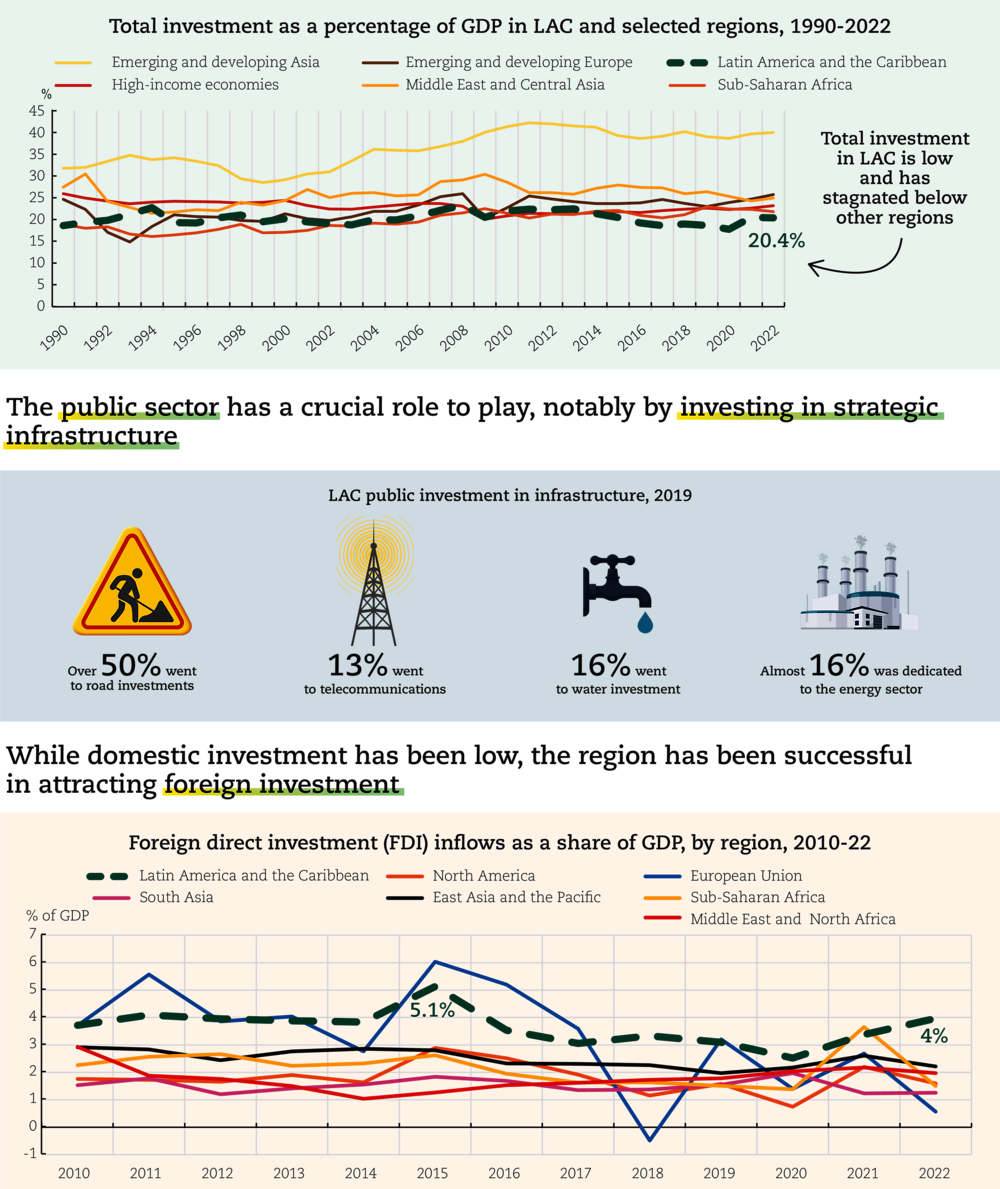
Introduction
Investment, if properly targeted, is a fundamental driver of sustainable development. It can be crucial in improving citizens’ well-being while also achieving broader socio-economic and environmental objectives. Nonetheless, total investment in LAC has remained low over the last 30 years; and in the past decade its level has been consistently lower than in other developing regions. More and better investment in strategic sectors is needed to boost production transformation and to craft a more inclusive and sustainable development model.
This chapter devotes special attention to the importance of strategic investment in quality public infrastructure for stronger development in LAC, particularly in key sectors such as sustainable transportation, telecommunications and water. It explores public-private partnerships (PPPs) and foreign direct investment (FDI) as enablers of better investment to deliver social and environmental impact. Other key investment areas are covered in Chapter 3, such as human capital, which is directly connected to production transformation.
The public and private sectors have strategic roles to play in securing more and better domestic and international investment. The public sector is responsible for providing essential services and goods, and for mobilising strategic investment in public infrastructure (infrastructure owned or available for use by the public). Moreover, the amount and quality of investment that is attracted will be determined by good governance and institutional frameworks (e.g. regulations and laws); transparency; the quality of institutions (e.g. rule of law, institutional co-ordination); and well-designed policies and programmes (e.g. fiscal and financial incentives) across transversal sectors (e.g. labour-market policies, entrepreneurship) (OECD, 2022[1]). Similarly, governments in the LAC region will need to promote and generate reliable sources of information and data that provide a clear visualisation of public and private current investments. In turn, the private sector, both national and foreign, can engage in developing quality infrastructure that brings well-being to surrounding communities.
This chapter begins by analysing the main investment trends in LAC, detailing investment levels per sector and their respective sources. Second, it assesses the main sectors of public infrastructure and how they can promote wider well-being and help LAC countries to move towards achieving the UN Sustainable Development Goals (SDGs). Third, the chapter highlights the crucial role of good governance in boosting the impact of investment in infrastructure. Fourth, the chapter stresses the importance of carefully implementing PPPs to boost the potential of public infrastructure. Fifth, the impact of FDI is analysed, looking into the sectors funded, the main investors, job creation and the effects of foreign investment on productivity, innovation and environmental sustainability. The chapter concludes by providing main policy messages for further consideration and implementation. A methodological annex at the end of the chapter provides details about the information presented in selected figures. Box 2.1 presents a brief compilation of definitions and considerations related to investment and infrastructure.
Box 2.1. Definitions, considerations and indicators for investment and infrastructure
Gross fixed capital formation (GFCF): This measures the total value of investment made by businesses (both non-financial and financial corporations), governments and households within a given economy (OECD, 2023[2]). GFCF is defined as “the acquisition of produced assets (including purchases of second-hand assets), including the production of such assets by producers for their own use, minus disposals. The relevant assets relate to assets that are intended for use in the production of other goods and services for more than one year. The term “produced assets” includes only those assets that come into existence as a result of a production process and, therefore, does not include, for example, the purchase of land and natural resources” (OECD, 2023[2]). GFCF is measured by “the total value of acquisitions less disposals, of fixed assets during the accounting period plus certain specified expenditure on services that adds to the value of non-produced assets”, such as the improvement of land (European Commission et al., 2008[3]). Since 2008, with the adoption of the new standards of the System of National Accounts (SNA), the expenses in research and development (R&D) and weapons systems are included in the GFCF (OECD, 2019[4]).
Gross capital formation (GCF): GCF is measured by “the total value of the GFCF, changes in inventories and acquisitions minus disposals of valuables” (European Commission et al., 2008[3]).
Investment: In this report, the term investment is used to refer to GFCF or GCF. According to the OECD Policy Framework for Investment, “investment can take many forms, from physical assets to human or intellectual capital. It can add capacity or simply improve the efficiency of existing assets such as through a change of ownership. Under the right conditions, it raises overall output both through factor accumulation and by introducing new techniques and processes which boost productivity and ultimately the country’s standard of living” (OECD, 2015[5]).
Public investment: “Public investment includes public gross fixed capital formation and acquisitions, less the disposal of non-produced, non-financial assets. Public gross fixed capital formation is the main component of public investment, which consists mainly of transport infrastructure, but also includes other investments such as office buildings, housing, schools and hospitals. Public administration consists of central, state and local government and social security funds” (OECD, 2019[4]).
Private investment: The private sector’s contribution to total investment refers to investment that has not been made by the government but is instead funded by households, companies or non-public organisations.
Quality public infrastructure: This concerns investment decisions in public infrastructure that “take into account the full externality effects of projects over the long term, including employment creation, social and environmental impacts, alignment with broader development strategies and the mobilisation of adequate resources” (OECD, 2021[6]). Public infrastructure is infrastructure owned or available for use by the public that encompasses essential services such as the energy, telecommunications, transport and water sectors.
Public-private partnerships: PPPs bring together the public and private sectors to finance and develop all phases of a public project, including construction, financing and operation (ECLAC, 2012[7]). PPPs tend to cover strategic public projects, such as hospitals, prisons, roads, schools, and water and sanitation (ECLAC, 2004[8]).
Foreign direct investment: FDI “is a category of cross-border investment in which an investor resident in one economy establishes a lasting interest in and a significant degree of influence over an enterprise resident in another economy. Ownership of 10% or more of the voting power in an enterprise in one economy by an investor in another economy is evidence of such a relationship” (OECD, 2023[9]).
Source: Based on (OECD, 2021[6]); (OECD, 2023[2]); (OECD, 2019[4]); (OECD, 2015[5]); (ECLAC, 2012[7]); (European Commission et al., 2008[3]); (ECLAC, 2004[8]); (OECD, 2023[9]).
Where does LAC stand in terms of investment?
The pattern of investment for the LAC region shows a general slowdown over the last three decades, which has stagnated below other developing regions. Total investment as a percentage of gross domestic product (GDP) dropped considerably even before the COVID-19 pandemic, declining by almost 2 percentage points from 2015 to 2019. By 2022, it averaged 20.4% of GDP, or around 2.8 percentage points less than total investment in high-income economies (23.2%). LAC also lags behind other developing regions in terms of total investment as a share of GDP. With 40% of GDP on average, emerging and developing economies in Asia show the highest levels of investment. Overall, the gap between LAC and other countries and regions has grown steadily since 2000. Since 2014, on average, every region has exhibited higher levels of total investment than LAC (Figure 2.1).
Figure 2.1. Total investment as a percentage of GDP in LAC and selected regions, 1990-2022

Note: As in (IMF, 2023[10]), data for each region corresponds to weighted averages. Investment, defined as gross capital formation, is measured by the total value of gross fixed capital formation and changes in inventories and acquisitions less disposals of valuables for a unit or sector [SNA 1993]. Investment is expressed as a ratio of total investment in current local currency and GDP in local currency. Middle East and Central Asia include 32 countries: Afghanistan, Algeria, Armenia, Azerbaijan, Bahrain, Djibouti, Egypt, Georgia, Iraq, Iran, Jordan, Kazakhstan, Kuwait, Kyrgyz Republic, Lebanon, Libya, Mauritania, Morocco, Oman, Pakistan, Qatar, Saudi Arabia, Somalia, Sudan, Syria, Tajikistan, Tunisia, Turkmenistan, United Arab Emirates, Uzbekistan and Yemen.
Source: (IMF, 2023[10]).
There is strong heterogeneity in LAC countries in terms of investment levels. In the Caribbean region, investment represented more than 32% of GDP in 2022 for countries such as Antigua and Barbuda, Dominican Republic, and St. Vincent and the Grenadines, while it was below 20% in Barbados, Puerto Rico and Haiti. In Central America and Mexico, average investment was 22.7% of GDP, while for South America the average was around 21% of GDP (Figure 2.2). From 2014 to 2020, countries that have shown a steady increase in investment levels are Antigua and Barbuda, Dominican Republic, Grenada, St. Vincent and the Grenadines, El Salvador and Paraguay (IMF, 2023[10]).
Figure 2.2. Total investment as a percentage of GDP in selected LAC countries, 2022
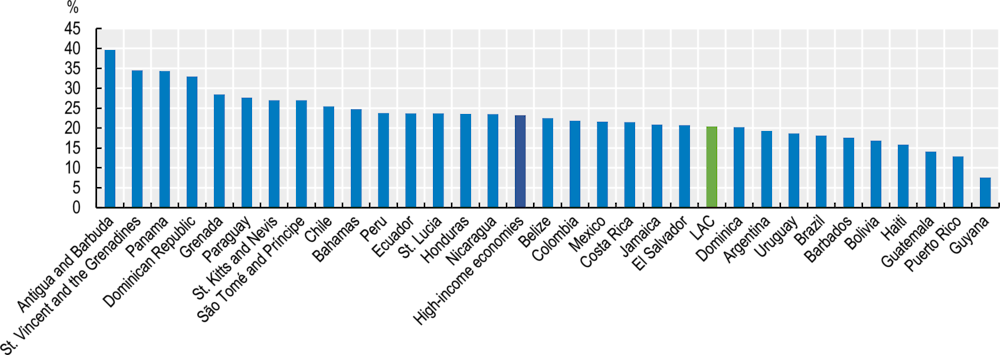
Note: As in (IMF, 2023[10]), data for LAC and high-income economies corresponds to weighted averages. Investment, defined as gross capital formation, is measured by the total value of the gross fixed capital formation and changes in inventories and acquisitions less disposals of valuables for a unit or sector [SNA 1993]. Investment is expressed as a ratio of total investment in current local currency and GDP in local currency.
Source: (IMF, 2023[10]).
Investment in LAC differs considerably across economic sectors. The share of investment per sector can be divided into three main groups. From 1990 to 2018, the largest proportions of total investment went to manufacturing (22.7%) and general services (21.1%). The second group – commerce (13.7%), mining industries (12.4%) and transportation (10.9%) – received almost 9 percentage points less investment. Finally, investments in agriculture (9.4%), electricity, gas and water (7.2%), and construction (2.6%) were below 10% of total investment (Figure 2.3). Notably, investment in construction goods as well as machinery and equipment has increased considerably over the last three decades in LAC. Over the period 1990 to 2020, the average annual growth rate of investment in machinery and equipment, at 4.4%, surpassed that of construction goods, at 3% (ECLAC, 2022[11]).
Figure 2.3. Share of total investment per economic sector in LAC, 1990-2018
As in other market-based economies, investments in most LAC countries are driven by the private and public sectors. The private sector includes what businesses, corporations, households and individuals invest in productive assets, such as investments in machinery, equipment, buildings, R&D, and other forms of fixed capital. Private investment is usually financed by private savings or by raising funds from financial markets and includes funding of infrastructure projects such as transport infrastructure, schools, hospitals, public transportation systems and other public assets as well as R&D. Public investment is typically financed by government expenditure or borrowing (Chapter 4). PPPs combine both sources of investment in collaborative projects (section below on PPPs).
The private sector is the main driver of investment in LAC; in 2019, it accounted for 78% of total investment. In Antigua and Bermuda, Bahamas, Chile, Dominican Republic and Guatemala, private investment represented more than 89% of total investment in 2019. The only LAC countries in which public sector investment exceeded private investment were Bolivia, Guyana and Venezuela. Overall, the share of private investment (78%) in total investment in LAC is below the OECD average of close to 84% (Figure 2.4). Historically (since 1990), private investment in LAC has represented 70% to 76% of total investment while public investment represented 24% to 30% (IMF, 2022[12]).
Figure 2.4. Private vs. public investment as a share of total investment in LAC and OECD, 2019
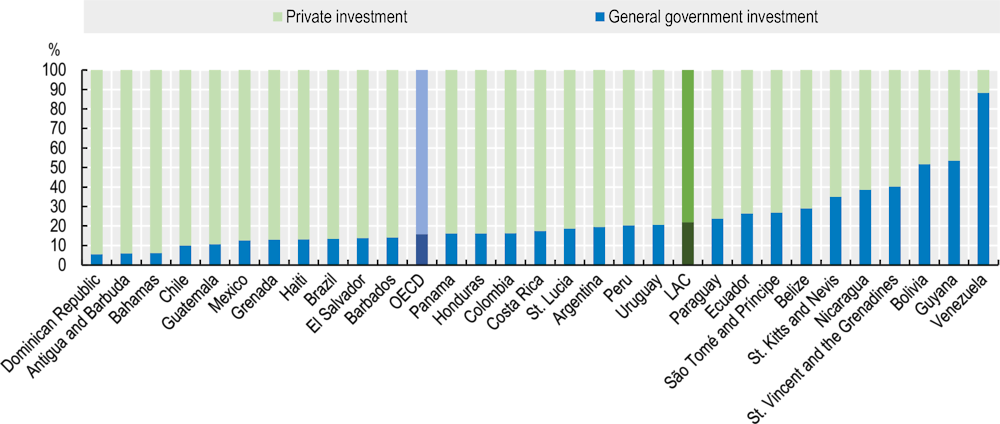
Note: The OECD average is a simple average of all member countries in 2019. The LAC average is a simple average of the countries for which data were available in the dataset: Antigua and Barbuda, Argentina, Bahamas, Barbados, Belize, Bolivia, Brazil, Chile, Colombia, Costa Rica, Dominican Republic, Ecuador, El Salvador, Grenada, Guatemala, Guyana, Haiti, Honduras, Mexico, Nicaragua, Panama, Paraguay, São Tomé and Príncipe, St. Kitts and Nevis, St. Lucia, St. Vincent and the Grenadines, Uruguay and Venezuela. See the Methodological Annex at the end of the chapter for general government and private investment calculations. The shares of total investment corresponding to private and general government investment were calculated taking into consideration the respective percentages of GDP represented by each category.
Source: (IMF, 2022[12]).
As the largest investor in LAC, the private sector should also be a key partner for the production transformation agenda, which requires more and better private investment. Until 2016, private investment showed high levels of concentration, with 1%, 5% and 10% of the region’s top companies being responsible, on average, for 25%, 55% and 69% of long-term investment, respectively (ECLAC, 2018[13]). To promote more – yet less concentrated – private investment, LAC governments can pursue a wide variety of strategies and tools. Chapter 3 explores specific tools to promote small and medium-sized enterprises (SMEs). Chapter 5 highlights the potential impact of international partnerships to promote private investment in strategic sectors, following the example of the European Union’s Global Gateway Investment Agenda (GGIA) in Latin America and the Caribbean. The next sections of this chapter cover strategic investment in quality infrastructure, effective PPPs and quality FDI.
Towards strategic investment in quality public infrastructure
This section focuses on the crucial role of the public sector and how quality public infrastructure can contribute to advancing a more sustainable and inclusive development model in LAC. It explores how better public infrastructure can promote private investment and act as a catalyst for further growth and connectivity. Particular attention will be given to the sustainable transportation, telecommunications and water sectors.
Public infrastructure encompasses essential services that have a direct impact on citizens’ well-being, and tends to focus mainly on the energy, telecommunications, transport and water sectors. Public infrastructure in these four sectors will be of true quality only if designed and implemented to support a sustainable production model that brings direct benefits to citizens. Following the G20 principles, quality infrastructure should also be resilient over time and to the effects of climate change and should include gender and transparency considerations (OECD, 2020[14]).
Quality public infrastructure can help governments advance towards the SDGs. Investment in public infrastructure can catalyse the achievement of poverty reduction (SDG 1), good health and well-being (SDG 3), quality education (SDG 4), clean water and sanitation (SDG 6), affordable and clean energy (SDG 7), decent work and economic growth (SDG 8), industry, innovation, and infrastructure (SDG 9), and sustainable cities and communities (SDG 11).
In turn, quality public infrastructure can help to attract more and better private investment in strategic sectors, such as energy, telecommunications and transport infrastructure – all crucial for developing most economic activities. Investment in telecommunications and transport infrastructure can act as a catalyst for further growth and connectivity, at national and subnational levels, by allowing national and international firms to connect with other regions and integrate in national, regional and global markets. Similarly, quality infrastructure in energy, telecommunications and water can provide better equipment to achieve the digital transformation and the green transition needed in the LAC region.
Public investment in public infrastructure in LAC has remained relatively low (on average) since 2008, although fluctuations throughout the years show it has been particularly sensitive to external shocks. It reached its highest levels in 2009 (2.6% of GDP) and 2012 (2.5% of GDP) but has since been declining due to several factors, including lower commodity prices and limited fiscal space. In 2021, public investment in infrastructure represented 1.6% of LAC’s GDP. The largest investments were in the transport sector (0.8% of GDP), followed by energy (0.3%), telecommunications (0.25%) and water (0.2%) (Figure 2.5, Panel A).
In general, transport infrastructure accounts for the largest public investment in the LAC region, with Bolivia (2.85%), Panama (2.2%) and Nicaragua (2.1%) showing the largest investments as a percentage of GDP in 2019. Energy received the second-largest share of investment, followed by telecommunications, leaving water receiving the lowest levels. With the single exception of Bolivia (1.12% of GDP), all LAC countries invested less than 1% of GDP in water infrastructure in 2019 (Figure 2.5, Panel B).
Figure 2.5. Public investment in infrastructure in LAC as a percentage of GDP, 2008-21
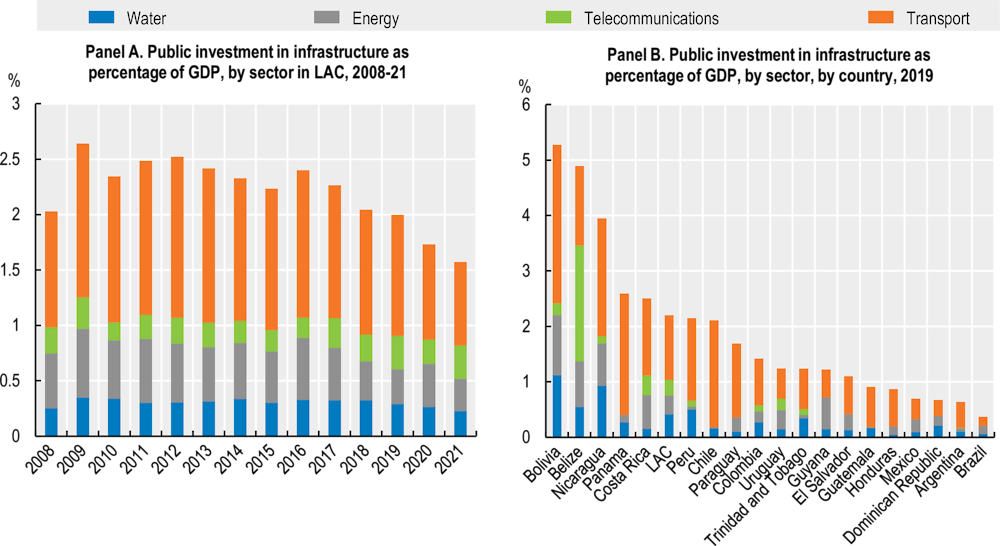
Note: See Methodological Annex for Panel B. Data from different countries were used depending on the sector and the year. Details provided in the source.
Source: (Infralatam, 2022[15]).
Most of the public investment in infrastructure in LAC is directed towards the road subsector. In 11 of 20 LAC countries analysed, road investments represented more than half of public investment in infrastructure and exceeded 60% in Honduras (78%), Paraguay (77%), Guatemala (74%), Peru (66%) and Panama (64%) (Figure 2.6). For transportation to be sustainable, further public investment is necessary in sectors other than roads (section on sustainable transportation).
To ensure that the production transformation increases citizens’ well-being and better aligns the region with the SDGs by 2030, governments in LAC need to increase substantially both the levels and the quality of investment in public infrastructure. To close the gap between current levels of investment and those necessary to achieve the 2030 SDGs, the LAC region will need an estimated investment of USD 2.22 trillion in public infrastructure – the equivalent of USD 282 per capita per year by 2030 (IDB, 2021[16]).
Figure 2.6. Public investment in infrastructure in LAC as a percentage of total investment, 2019
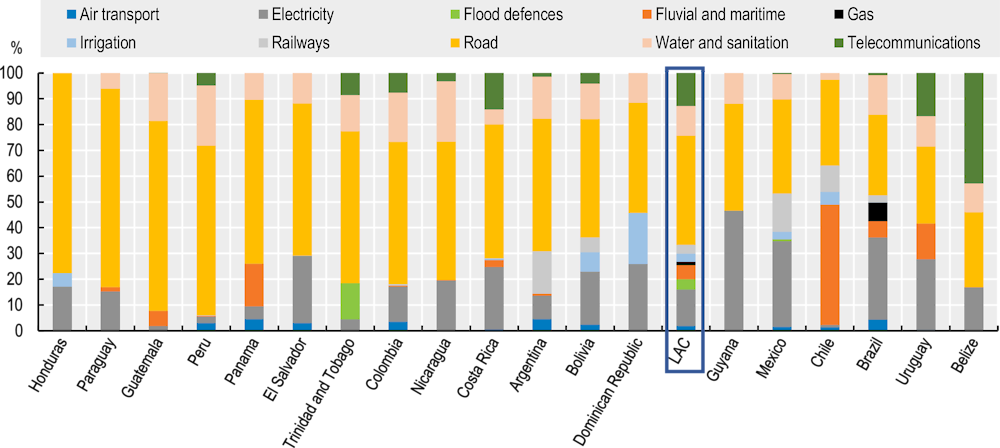
Note: Sectors under consideration (including water, transportation, energy and telecommunications) centre primarily around infrastructure services and essential utilities. As such, infrastructure investment related to oil and gas production, oil refinement and petrochemistry is excluded. Social infrastructure is also excluded (e.g. schools, hospitals, dwellings and security infrastructure). Telecommunications represents fixed-line telephone services, mobile and satellite telephony, and data and internet connection services. The other sectors are subdivided into subsectors. Water includes water and sanitation (drinking water supply through the grid, provision of sanitation services); flood defences (urban and rural projects for mitigating the effects of flooding); and irrigation (facilities and systems of artificial irrigation). Transport includes roads and paths; urban mass transportation; railway transportation (infrastructure and rolling stock); air transport; and fluvial and maritime transportation. Energy includes generation, transmission and distribution of electricity; and transmission and distribution of natural gas.
Source: (Infralatam, 2022[15]).
A sustainable transport sector is fundamental to boosting structural change
Achieving sustainable transport in LAC is challenged by the current public investment bias towards roads in the transport sector. In 2019, for example, the region’s average investment for roads was 42.3% of total investment in infrastructure, while for railways it was only 3.4%. Considering environmental conditions, distances and socio-economic needs, public investment urgently needs to increase in areas of transport other than roads. To make transport inclusive and sustainable, investment in roads must be complemented by investment in sustainable public transport and electrification of the different types of transportation (OECD et al., 2022[17]).
More and better investment in transport connectivity will also prove crucial, as the condition of available transport infrastructure has direct impacts on the ability to attract new investments and on developing potential trade relations among countries in the region. As it also supports extension of commercial connectivity among the local territories of each country, quality transport infrastructure can expand and strengthen the production transformation (CAF, 2021[18]).
Inland waterways and maritime transport received the LAC region’s second-largest share (5.4% of total investment) of public investment in transport infrastructure in 2019, with Chile, Panama and Uruguay having the highest investments in this subsector (Infralatam, 2022[15]). In South America, maritime transport accounted for approximately 95% of total foreign trade operations, making it the subregion’s dominant mode of transportation. This is being driven by the increased share in total trade of agricultural and mining goods, which demand port infrastructure for handling bulk cargo. In Mexico and Central America, maritime transport is also the primary mode (48%) of transportation for international trade, followed by road transport (42%). Maritime transport can boost production transformation by connecting the LAC region’s products with potential markets overseas. Ports, however, represent a particular challenge: Europe has 45% more maritime connectivity than the average of selected LAC countries. Key strategies for improving maritime transport in LAC include: investing in better port infrastructure; ensuring complementarity in port improvements; reducing vessel waiting times; and embracing the digitalisation of logistic procedures (CAF, 2021[18]).
Within the transport sector in LAC, the smallest shares of public investment (on average) have gone to air transport (only 0.04% of GDP) and railways (0.08% of GDP) (Infralatam, 2022[15]). In South America in 2018, air transport and railways together represented less than 1% of total foreign trade operations, well below the 10% directed to railways in North and Central America (ECLAC, 2019[19]). Governments in the region should continue exploring the benefits of promoting these means of transport. Boosting investment in sustainable railway infrastructure could, for example, provide a cheaper and more sustainable means of transport for exporting goods by connecting different stages of strategic value chains. Regarding air transport, closer collaboration with the private commercial airline sector could help to expand export capacity for certain products without causing fleet multiplication and additional impacts on the environment.
To address the rising energy-related greenhouse gas (GHG) emissions in LAC driven by the transport sector, governments must prioritise environmentally responsible investment in transport infrastructure. Future investments represent an opportunity to advance infrastructure that: promotes public and electric transport over private mobility; and is adapted to its environment, respecting local communities and wildlife. Notably, urban passenger and freight transport demand in the LAC region currently outpaces global averages: by 2050, passenger demand is projected to increase by 3.5 times and freight demand by 1.9 times (OECD et al., 2022[17]). Long-term planning is crucial to clarify actions and secure funding for transport decarbonisation, particularly in light of constrained public funding and the potential of private sector involvement and international funding options (Chapter 5) (ITF and IADB, 2022[20]).
Enabling investment in telecommunications
LAC governments should mobilise additional public and private investment in telecommunications to advance a sustainable and inclusive development model. While most LAC countries lag behind the OECD average in broadband access, recent progress in availability, usage and skills has been observed in Costa Rica, Suriname, Brazil and Colombia (OECD and IDB, 2016[21]). Investment in telecommunications that increases the levels of coverage can extend the benefits of the production transformation across territories and jurisdictions. It can also increase well-being dimensions such as access to health and education (OECD et al., 2020[22]; IDB, 2023[23]). Investment in R&D is a key complementary area for fostering innovation and digital transformation (Chapter 3).
The level of public investment in telecommunications in LAC is currently low: in 2019, it stood at less than 1% of GDP in almost every country. To close the digital gap between LAC and OECD countries, mobilising further private investment for telecommunications will be crucial. An estimated USD 68 billion will be needed to enlarge mobile and fixed broadband coverage to the necessary level (IDB, 2022[24]). In 2021, the telecommunications industry’s gross sales constituted approximately 2.1% of GDP in several LAC countries, including Argentina (1.8%), Brazil (1.5%), Chile (2%), Colombia (2.1%), Mexico (2%), Paraguay (2.9%) and Uruguay (2.5%) (IDB, 2023[23]).
LAC governments have a crucial responsibility to work more closely with the private sector to maximise the socioeconomic benefits of digital transformation. Constant co-ordination between the public and private sectors, a well-established business framework, administrative simplification, and stronger and credible institutions could ensure that investments in telecommunications infrastructure provide a source of knowledge and technology transfer, thereby delivering benefits to both urban and rural areas throughout the region (Chapter 3) (OECD et al., 2020[22]). Implementing a sustainable and inclusive expansion of broadband internet in LAC could not only create more jobs and improve the productivity and efficiency of the public sector but also strengthen health and educational services, facilitate access to cultural content, and promote the preservation of natural and cultural patrimony (Atlantic Council, 2023[25]; IDB, 2022[24]).
Fifth-generation (5G) mobile networks could help to close the urban-rural gap and advance a sustainable and inclusive development model. Notably, 5G mobile networks provide high connection speeds with faster deployment at lower costs. Their deployment could reduce disparities of access in medium- or low-density areas in both large cities and small towns or villages (ECLAC, 2022[26]). To date, however, 5G deployment has been slow in the region, with a penetration rate of just 12% projected for 2025. The investment in capital goods required to roll out these networks in six countries – Argentina, Brazil, Chile, Colombia, Mexico and Peru – would range from USD 50.8 billion to USD 120.07 billion by 2030, depending on whether deployment takes place only in more highly populated areas or nationwide. This implies that telecommunications service operators would have to increase their annual capital expenditures by 10% to 40% (ECLAC, 2021[27]).
The strategic water sector needs further investment
The water sector, and all of its subsectors, requires further and more strategic investment as it is closely linked with human development. In 2019, the largest share of water investment went to the water and sanitation subsector, but the regional average remains low (11.6% of total investment in infrastructure). While LAC has multiple sources of potentially potable water, a pressing need exists for further investment to ensure equitable access, which is vital for development, reducing inequalities, enhancing global food security and alleviating poverty. Currently, 34% of Latin American households rely on bottled water as their main water source; of those connected to water networks, 41% reported having insufficient potable water (IDB, 2022[28]).
The water sanitation subsector requires comprehensive capacity building that combines physical infrastructure investment with institutional development to address knowledge gaps, staffing issues and obsolete infrastructure. Additionally, to foster well-functioning institutions that support effective investments in water development, it is crucial to create stable and sufficient revenue sources at sub-national levels while considering various financing challenges associated with the different water cycles (services, ecosystems and natural resources) (OECD, 2012[29]). Moreover, improving the quantity and quality of investment in the water and sanitation subsector could help LAC governments move closer to SDG 6.1, which aims to achieve universal access to safe drinking water, with an emphasis on safely managed access.
The situation is similar in the irrigation and flood defences subsector, closely linked to the production transformation. In 2019, only 3.24% of total infrastructure investment in LAC went to irrigation and 4.05% to flood defences (Infralatam, 2022[15]). Both of these subsectors are crucial to limiting the impacts of climate change in strategic sectors, such as the sustainable agro-livestock industry. Better irrigation systems could help fight the consequences of droughts in rural areas, while better flood defences could help avoid the consequences of flooding in areas dedicated to sustainable fish cultivation.
In coastal countries, sustainable investment in maritime infrastructure can bring multiple benefits to the surrounding communities and environment. Construction of sustainable coastlines can directly boost strategic sectors such as sustainable fishery and tourism, while platforms for wind power projects can foster the generation of renewable energy. In 2018, ocean services contributed USD 25 billion to total GDP for LAC as a whole, and USD 7 billion for Caribbean countries alone (OECD et al., 2022[17]).
Boosting investment requires good public governance and transparency
Governments have a central role in creating an environment conducive to investment through good public governance. This requires a mix of co-ordinated policy efforts, as described by the OECD Policy Framework for Investment (Box 2.2) (OECD, 2015[5]).
Box 2.2. The OECD Policy Framework for Investment
The OECD Policy Framework for Investment (PFI) is a comprehensive tool for evaluating and enhancing the investment climate in a country. It covers ten policy areas: investment policy; trade policy; competition policy; taxation; corporate governance; business conduct; human resource development; infrastructure; financing; and public governance.
Under the PFI, key pillars for ensuring good and efficient public governance include quality regulation, transparency, openness and integrity. These dimensions span issues such as improving regulatory frameworks; administrative simplification; regulatory impact assessments; regulatory compliance and enforcement; governance and institutional structure; regulatory coherence across levels of government and jurisdictions; open government; public integrity and public procurement. The PFI also covers conflict-of-interest management, application enforcement and review of anti-corruption laws and regulations as well as international anti-corruption and integrity standards and initiatives. Having effective measures in place for all of these can significantly enhance investor confidence.
Regulatory frameworks and public integrity play a pivotal role in shaping the investment climate. Regulations that are poorly conceived or weakly enforced can obstruct market entry, drain resources that could be better invested elsewhere, limit job growth and generally discourage investment. Investor confidence in regulation is perhaps bolstered most strongly by the assurance of stability and the understanding that the rules are effective in meeting their intended goals. The quality of public services, determined both by internal government regulations and by those imposed on private sector providers, greatly impacts the investment climate. From an investor’s perspective, regulatory policy should deliver clear directives and standards for governmental officials, as well as clearly defining what investors can anticipate in terms of government regulation.
Source: OECD Policy Framework for Investment (OECD, 2015[5]).
Governments need to be trustworthy and transparent to attract investments. This is particularly true for infrastructure, as these are usually long-term investments that require a predictable and stable horizon. Political certainty, trustworthiness and an integrity culture help to encourage confidence among investors that the country’s policies, regulations and contracts will be honoured and that any changes will be consulted on and implemented fairly and predictably. These elements reduce potential risks for investors and enhance the country’s reputation as a secure place to do business (OECD, 2015[5]). Transparency ensures that investors have access to the information they need to make informed decisions. This includes information about the country’s laws, regulations, economic indicators and specific investment opportunities. Transparency can also help to ensure that investments are applied efficiently and effectively, rather than misallocated or misused whether due to corruption or negligence.
The adoption of a transparency normative framework, such as “access to information” acts and regular exercises of accountability, can serve as a positive sign for potential investors from the private sector (OECD, 2015[5]). Governments could strengthen trust among stakeholders by encouraging fiscal transparency, access to information on how projects and investments are assigned, and asset disclosure.
Transparent public procurement at national and local levels can also reassure stakeholders from the private sector and civil society. By aiming for efficient, effective, economic and accountable processes of procurement, governments can help to prevent misuse of funds, increase customer satisfaction and promote better services (OECD, 2015[5]). The OECD Recommendation on Public Procurement highlights the importance of ensuring transparency throughout the procurement process, both by providing clear and fair conditions for potential suppliers and by enabling access to updated information for everyone (OECD, 2015[30]).
Policy coherence can ensure that the investment mobilised helps to achieve the SDGs and the objectives of sustainable and inclusive production transformation. Given the long timeframe of infrastructure investment, it is also crucial to align the objectives of public infrastructure with those of national development and investment plans. Moreover, given the number of stakeholders involved in the financing and implementation of infrastructure projects, active co-operation among all relevant jurisdictions will be needed to ensure inclusive and participative policy design (Chapter 4).
Investment regulatory frameworks should aim not only to increase participation of the private sector but also ensure the generation of positive externalities in the surrounding communities and environment. To achieve this, regulations should include a number of strategic elements.
First, the design of the regulatory framework for infrastructure should promote competition among investors, which in turn could generate more innovation and sustainable methods of production. The new regulations should aim to assure clarity and transparency, enabling investors to plan their investments over long-term periods. Similarly, a clear distribution of responsibilities among stakeholders for each investment can help to avoid future conflicts or create additional costs. Finally, efforts to achieve vertically harmonised regulations in line with similar national, regional and international frameworks could avoid duplication of processes and provide more clarity (OECD et al., 2020[22]). Similarly, horizontal harmonisation of regulations across investment, trade and fiscal systems could also prove beneficial to boost production and avoid tax evasion.
Up-to-date and reliable data are also crucial for understanding the needed investment and for mobilising private investment towards strategic sectors. LAC currently suffers a lack of information on issues such as: which private investors will invest or are already investing in which sectors; how much they are investing; and under what conditions. Governments will need to strengthen their collaboration with the private sector and academia to promote easy access to relevant databases and ensure efficient use of the resources already deployed. Good data are essential for sound cost-benefit analyses and successful promotion of investment.
Voluntary government-led initiatives, such as contract guidelines and data partnerships, can enhance access to and sharing of data. The Netherlands’ Dare-2-Share Co-operation Agreement is a good example of how collaboration among stakeholders can help define legal standards and references to assist entrepreneurs in establishing trustworthy and transparent agreements during the phase of collaboration in innovation, allowing data exchange between large and small businesses. Similarly, Digital Hub Denmark promotes exchange between the public and private sectors to mutually enrich their data sets. In LAC, a regional effort is the Caribbean Open Institute, which encourages open development approaches to inclusion, participation and innovation, using open data as a catalyst (OECD, 2019[31]). Reliable information about strategic sectors can facilitate the analysis of potential investments, while up-to-date information on current infrastructure can strengthen the policy-making process and attract private investors. Box 2.3 presents an example of a partnership between the public and academic sectors to improve statistical measurement in infrastructure.
Box 2.3. From Mexico, a guide for strengthening statistical measurement of infrastructure
Detailed and reliable information is necessary for clear measurement of infrastructure investments. This information should cover every jurisdiction, from national to local infrastructure.
A Mexican initiative offers an example of a partnership between the public and academic sectors that aims to improve data on infrastructure. The country’s National Institute of Statistics and Geography (INEGI for its initials in Spanish) and the University Programme of Development Studies at the National Autonomous University of Mexico (UNAM) collaborated to develop a step-by-step guide to strengthening national measurement systems for public infrastructure.
In line with this guide, governments could benefit from efforts to:
-
collect, organise and build existing infrastructure databases
-
choose and adopt a definition of infrastructure to better delineate the extent and type of information that should be collected
-
prioritise the main sectors to be included in the measurement and assign the research to experts who know the particularities of each sector
-
decide whether measurement of public infrastructure will be done in physical terms (e.g. number of km) or monetary terms (e.g. as a percentage of GDP)
-
choose between the two main methodologies – i.e. the perpetual inventory system and the common inventory method – for evaluating the efficiency of the sums invested
-
engage in peer learning exercises to learn from successful cases.
Regarding methodology, the perpetual inventory system has proven to be the most widely used form of valuation as it allows construction of capital stock data taking account of investment flows. The main information to be gathered is capital investment data in constant prices and the economic lifetime of each asset. After estimating the consumption of fixed capital and specifying its depreciation, it is possible to move from a stock of gross capital to a stock of net capital.
Regarding peer learning, an interesting example comes from Canada, where the government developed an Infrastructure Statistical Hub, with statistical information on the amount of investment, type of assets, economic contribution and environmental impact.
Note: Additional considerations for the measurement of the perpetual inventory system are included in the original recommendation.
Source: (INEGI, 2023[32]).
Good governance of the LAC region’s infrastructure is crucial to ensuring that investment in infrastructure, both public and private, brings well-being to the citizens without harming the surrounding environment and wildlife. Recommendations from the OECD on the governance of infrastructure provide detailed guidance for countries (Box 2.4).
Box 2.4. OECD recommendations on the governance of infrastructure
The OECD recommendations on the governance of infrastructure cover ten priority areas.
Of special interest for LAC is a recommendation inviting countries to promote a coherent, predictable and efficient regulatory framework. It encourages governments to identify their main policy goals and to complement them, if necessary, with new regulations and additional means to find the best approach to promote their objectives. The recommendation also suggests including relevant stakeholders in the design and implementation of new regulations, from representatives of different levels of government to relevant stakeholders, such as the private sector. The OECD highlights the importance of implementing systematic reviews of existing regulations to ensure their validity and of promoting good governance practices such as transparency and accountability, among others.
Another recommendation of interest for LAC invites countries to promote evidence-informed decision making. It suggests identifying and clearly allocating institutional responsibilities for collecting, processing and disseminating reliable data, and calls for establishing systems that gather relevant information throughout the entire life cycle of an infrastructure project. The recommendation highlights the need to harness digital technologies and data analytics “to reduce administrative burdens, increase transparency, understand performance, inform decision making and take preventive actions” to respond to risks.
The OECD recommendations also call for:
1. adopting a long-term vision
2. guarding fiscal sustainability, affordability and value for money
3. ensuring efficient and effective procurement of infrastructure projects
4. ensuring transparent, systematic and effective stakeholder participation
5. co-ordinating infrastructure policy across levels of government
6. implementing a whole-of-government approach to manage threats to integrity
7. making sure the asset performs throughout its life
8. strengthening critical infrastructure resilience.
The main governance messages in Chapter 4 provide further details on the OECD recommendations.
Source: (OECD, 2020[33]).
Effective PPPs can help boost investment in public infrastructure in LAC
Governments across the LAC region can harness PPPs as a powerful tool to accelerate the development of strategic sectors that are pivotal for a production transformation. The evolution of PPPs for public infrastructure projects in LAC as a percentage of the region’s GDP has oscillated in recent years, with the largest share in 2012 (1.3%) and the lowest in 2018 (0.32%) (Figure 2.7). In 2021, LAC’s share of PPPs for public infrastructure (0.46% of GDP) was larger than those of Sub-Saharan Africa (0.31%), South Asia (0.26%), East Asia and the Pacific (0.16%), and the Middle East and North Africa (0.05%), and was only slightly surpassed by Europe and Central Asia (0.47%) (World Bank, 2021[34]). Between 2009 and 2022, 94.5% of the active or concluded infrastructure projects in LAC were conducted by private parties having at least a 60% participation in the project contract (World Bank, 2023[35]).
Figure 2.7. PPPs for public infrastructure projects in LAC as a percentage of GDP, 2010-21
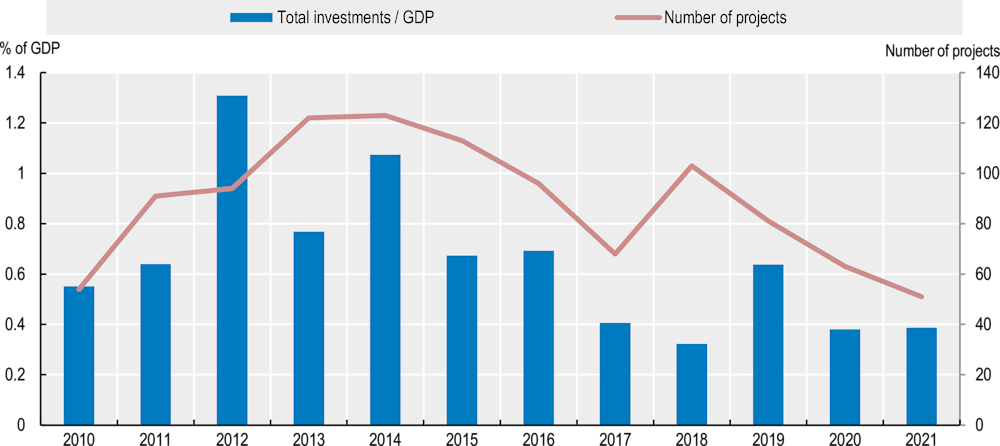
Note: The World Bank’s Private Participation in Infrastructure (PPI) database records contractual arrangements for public infrastructure projects that have reached financial closure in which private parties assume operating risks by covering projects with at least a 20% private ownership stake (except for divestitures, which are included with at least a 5% stake) and may include public participation. The World Bank’s estimation of the percentage of GDP considers all kinds of projects, including those interrupted and cancelled. “Total Investment” is the sum of investment in physical assets and payments to the government; it is recorded in millions of USD. The World Bank Indicator “GDP at current USD” was used to build the ratio with the total investments variable.
Source: Authors’ elaboration based on (World Bank, 2023[35]); (World Bank, 2023[36]).
The evolution of the total number of infrastructure projects in LAC has followed the trend of PPP as a percentage of GDP (Figure 2.7). This tendency applies as well to the types of projects that normally receive funding, indicating that room exists for diversification. In 2022, the majority of 80 active or concluded infrastructure projects with private participation in LAC took place in Brazil (more than 64%), followed – at much lower shares – by Colombia (11%) and Peru (9%). The fewest such projects took place in Jamaica, El Salvador, Mexico and Paraguay, with only 1 PPP each (1.25%) (World Bank, 2023[35]). Most PPP investment in LAC is directed toward the energy sector (67.5% of total projects), followed by the transport sector (26.25%). The least-funded sectors are water and sewerage (5%) and municipal solid waste (1.25%). To cite the value of one instance, the use of PPPs in water management in Cartagena, Colombia, substantially improved service quality by expanding water supply coverage and providing access to piped water (World Bank, 2016[37]; OECD, 2009[38]).
The increasing adoption of PPPs in LAC over the past decade reflects progress in the region’s regulatory, institutional and economic climate. An analysis of the environment for PPPs in 21 LAC countries showed that, by 2019, 14 had established markets for undertaking PPPs, up from just five in 2014. Additionally, it showed that partnerships were established in sectors ranging from conventional areas (such as transport, energy and water) to more innovative areas (e.g. government offices, health care, sports and justice) (EIU, 2019[39]). Progress over the last decade is also evident in that 16 countries set up agencies dedicated to promoting, supervising and providing technical assistance for PPPs (Economist Impact, 2022[40]). Notably, Chile, Colombia, Costa Rica, Mexico and Peru adhered to the OECD Recommendation on Principles for Public Governance of Public-Private Partnerships. However, while political endorsement of private investment in infrastructure development is increasing, areas for improvement remain, including enhanced transparency, accountability and sustainable practices.
Elements that create an enabling environment for PPPs in a country include regulations and institutions; project preparation and sustainability; financing; risk management and contract monitoring; and performance evaluation and impact (Economist Impact, 2022[40]).
Although some LAC countries have shown strong improvements in adherence to PPP regulations and have more robust financial capacities, significant regional disparities exist in project preparation and sustainability. Notably, substantial gaps exist in the management of PPPs, with improvements needed in risk management, project monitoring, and assessment of the economic and social impacts of operational PPPs (Figure 2.8) (Economist Impact, 2022[40]).
Figure 2.8. Key aspects that determine a country’s readiness and capacity to implement PPPs
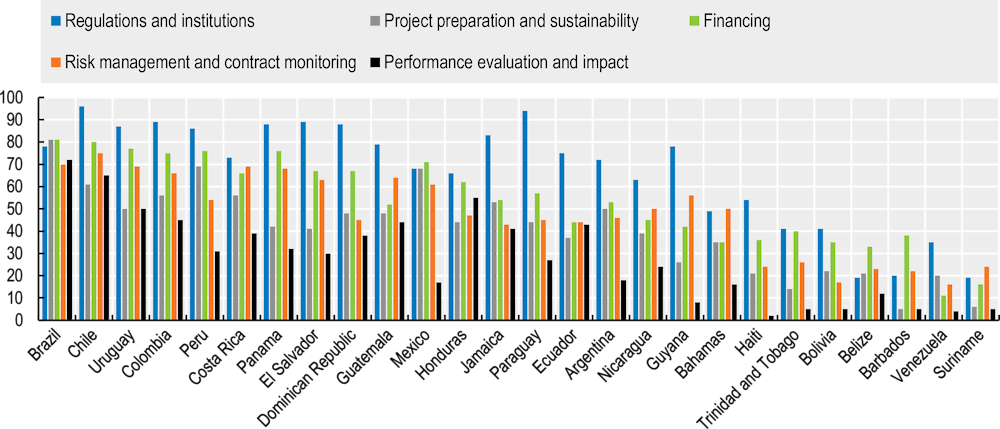
Note: Scores from 0 to 100, where 100 = best. The countries are ordered according to their overall score, from highest to lowest.
Source: (Economist Impact, 2022[40]).
Successful implementation of PPPs depends on underlying regulatory and institutional factors. Institutional inadequacy, uncertainty posed by political instability, endemic corruption and hurdles in long-term financing have presented significant difficulties for the deployment of effective PPPs in some LAC countries. Weak state institutions, unclear legislation and deficient contract design, for example, have allowed for frequent and costly renegotiation of road concessions (Bitrán, Nieto Parra and Robledo, 2013[41]). There is thus a substantial risk of inefficiencies such as poor project selection, cost overruns, delays and misallocated risk distribution. These factors contribute to an investment environment that discourages effective private-sector participation, further undermining the development of PPPs in LAC (CAF, 2018[42]).
Addressing these concerns requires a robust regulatory framework characterised by transparency, capacity building and political stability (Engel, Fischer and Galetovic, 2021[43]). Regulatory clarity and consistency ensure investor confidence, and thus the longevity of PPPs, while integrity and transparent processes mitigate the risk of corruption and enhance value for money. Essential to the success of PPPs is the ability of governments to build technical expertise for the design, implementation and oversight of such projects. Moreover, political stability, marked by the honouring of contracts across political cycles, can bolster an environment conducive to long-term investment in PPPs.
Citizen participation in PPPs fosters transparency, accountability and social inclusion (World Bank, 2019[44]). In turn, it enhances the credibility of the partnership by allowing for the incorporation of diverse perspectives, thereby contributing to more effective and inclusive decision making (Chapter 4). Moreover, public involvement improves the social acceptability of projects, reduces the risk of public backlash and can contribute to identifying local needs, ultimately leading to better targeted and more sustainable solutions. Efforts should be made to enhance citizens’ capacity to engage meaningfully in these processes, ensuring that citizen participation leads to tangible impact rather than being a mere formality (ECLAC, 2020[45]).
Given the long-term framework of infrastructure projects, governments can promote PPPs by establishing regular consultations with representatives from the private sector throughout the investment cycle to ensure against interruptions and prevent potential conflicts. To avoid uncertainties and, in the end, further fiscal costs, well-designed regulatory and institutional frameworks are fundamental to reducing the risk of renegotiation costs.
The share of public investment and the availability of blended finance mechanisms – with de-risking elements offered by national governments – could contribute to encouraging private investors to participate in PPPs (Chapter 5). About 27% (on average) of the active or concluded PPPs in Latin America from 2010 to 2017 received some form of direct or indirect government support. Payment guarantees were the most common (14.4%), followed by tax deductions (10.0%), capital subsidies (7.5%) and revenue subsidies (1.6%) (World Bank, 2023[35]).
If well designed and implemented, PPPs could help LAC governments attract private funding into public infrastructure projects with high social impact and promote innovation, thus contributing to a sustainable and inclusive production model. The public sector currently accounts for the largest share of total public infrastructure investment in the region, with around 33.3% provided by the private sector (IDB, 2022[46]). While private investment in public infrastructure is low in LAC compared with OECD countries, it remains higher than in other developing regions. In terms of percentage of regional GDP, LAC had the highest share of private participation in infrastructure in 2022 (0.53%), above South Asia (0.34%), Sub-Saharan Africa (0.25%), and East Asia and Pacific (0.21%) (World Bank, 2022[47]).
It is important to note that PPPs can sometimes be at odds with environmental considerations, due to the inherent tension between infrastructure development and long-term sustainability goals. Incorporating a comprehensive environmental impact assessment in the planning stages of PPPs is essential to mitigate these potential conflicts (OECD, 2008[48]) (Chapter 4). Robust policy frameworks and enforcement mechanisms are also key to ensuring adherence to environmental regulations, along with the promotion of transparency and stakeholder engagement to guarantee environmentally and socially responsible land use. International partnerships can play an important role in mobilising greater public and private investments that yield greater social impact (Chapter 5).
Enhancing quality foreign direct investment
Although global FDI decreased by 24% in 2022, FDI inflows increased by 55% in LAC, reaching almost USD 225 billion.1 In relative terms, with inflows equivalent to 4% of GDP, LAC was the top destination for FDI in 2022, a position also held in 2018 and 2020. In 2022, the LAC region was followed by East Asia and Pacific (2.2% of GDP), Middle East and North Africa (2%), North America (1.6%), Sub-Saharan Africa (1.5%), South Asia (1.3%) and the EU (0.6%). The rise in FDI inflows in LAC was driven by a marked interest in services, hydrocarbons and manufactures in the countries with the largest capacities (ECLAC, 2023[49]) (Figure 2.9).
FDI represents a substantial influx of capital for LAC countries compared to the Marshall Plan. FDI to the LAC region represented USD 464 billion between 2017 and 2019, and it decreased slightly to USD 445 billion during the post-COVID, from 2020 to 2022 (ECLAC, 2023[49]; ECLAC, 2023[50]). To put these FDI inflows into perspective, for the periods 2017-19 and 2020-22, FDI represented the equivalent to 290% (USD 464 billion) and 278% (USD 445 billion), respectively, of the financial resources provided by the Marshall Plan to promote Europe’s recovery after World War II (USD 13 billion in 1948 equivalent to USD 160 billion in 2022). Similarly, while the Marshall Plan amounted to around 2% of the combined national incomes of the recipient countries between 1948 and 1951 (Eichengreen, 2010[60]), FDI in LAC surpassed 3% of GDP in the periods 2017-19 and 2020-22 (and 4% of GDP in 2022).
Figure 2.9. FDI inflows as a share of GDP, by region, 2010-22
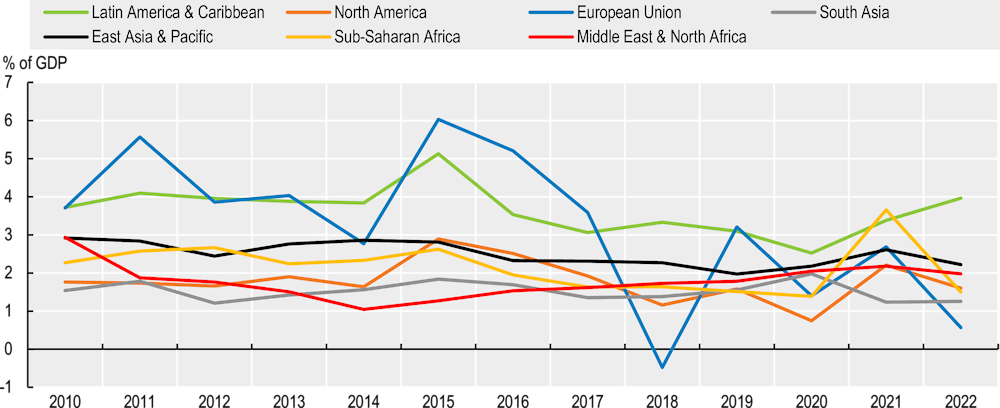
Note: As in (World Bank, 2023[36]), data for each region corresponds to weighted averages. For the LAC region, 37 countries were taken into account with available data for 2022: Antigua and Barbuda, Argentina, Aruba, Bahamas, Barbados, Belize, Bolivia, Brazil, Cayman Islands, Chile, Colombia, Costa Rica, Curacao, Dominica, Dominican Republic, Ecuador, El Salvador, Grenada, Guatemala, Guyana, Haiti, Honduras, Jamaica, Mexico, Nicaragua, Panama, Paraguay, Peru, Saint Kitts and Nevis, Saint Lucia, Saint Vincent and the Grenadines, Saint Maarten, Suriname, Trinidad and Tobago, Turks and Caicos, Uruguay and Venezuela. The latest data available for Aruba, Curacao and Cayman Islands corresponds to 2021, while for Venezuela it corresponds to 2014.
Source: Authors’ elaboration based on (World Bank, 2023[36]).
More than half of FDI inflows to the LAC region in 2022 went to Brazil and Mexico. In Brazil, the inflow totalled USD 91 billion (41% of LAC FDI) while Mexico received USD 39 billion (17%). For Brazil, the share of FDI exceeded its participation in LAC’s GDP (34%), while for Mexico it was lower (25%). Although FDI inflows received by the region expanded by 55% from 2021 to 2022 – and grew significantly in most subregions, notably in South America (81.8%) – they decreased by 11.9% in Central America (excluding Mexico).2
Wide heterogeneity in FDI flows is evident across LAC countries. Uruguay (13.1%), Nicaragua (8.3%), Chile (6.9%) and Costa Rica (5.4%) performed exceptionally well with FDI levels above the LAC average of 4% of GDP. In contrast, the lowest levels of FDI went to Paraguay (1.1%) and Ecuador (0.7%), while Bolivia presented disinvestment, with negative FDI inflows of -0.1% (Figure 2.10).
Figure 2.10. FDI inflows as a percentage of GDP, selected LAC countries, 2013-22
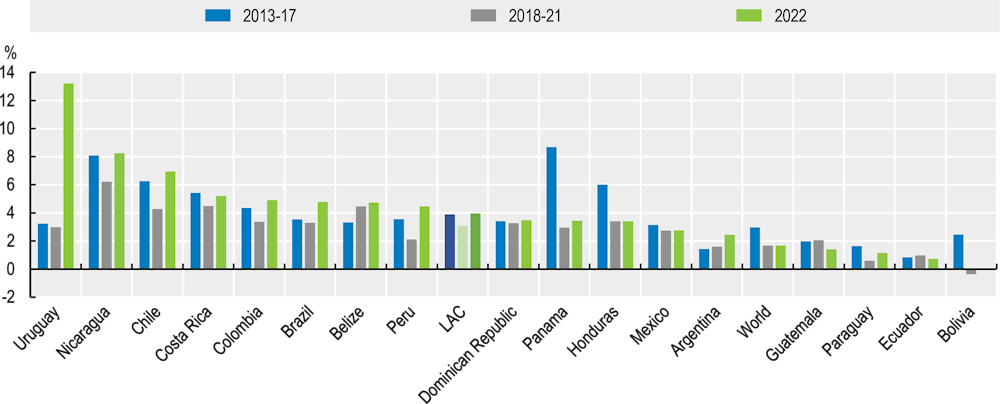
Note: The data for 2013-17 and 2018-21 corresponds to averages over time. As in (World Bank, 2023[36]), the 2022 data for LAC corresponds to a weighted average which includes 33 countries: Antigua and Barbuda, Argentina, Bahamas, Barbados, Belize, Bolivia, Brazil, Chile, Colombia, Costa Rica, Dominica, Dominican Republic, Ecuador, El Salvador, Grenada, Guatemala, Guyana, Haiti, Honduras, Jamaica, Mexico, Nicaragua, Panama, Paraguay, Peru, Saint Kitts and Nevis, Saint Lucia, Saint Vincent and the Grenadines, Sint Maarten, Suriname, Trinidad and Tobago, Turks and Caicos and Uruguay. For Aruba, Curacao and Cayman Islands the latest data available corresponds to 2021, while for Venezuela the latest data available corresponds to 2014.
Source: Authors’ elaboration based on (World Bank, 2023[36]).
Based on the final destination of investment by FDI project announcements, the EU and the United States of America (USA) are the largest investors in LAC, consistently accounting for more than half of the region’s FDIs.3 In 2022, the top investor was the USA, with 41% of the value of project announcements, followed by the EU (20%). About 8% of FDI in the region originated from LAC countries, followed by the People’s Republic of China (hereafter “China”) (4%), the United Kingdom (4%) and Canada (2%), while other countries combined accounted for 20%. Although EU investment in LAC decreased in 2022 (by 6 percentage points from 2021), the European Union maintains a strong position as a main FDI partner for LAC over the years (Figure 2.11). Within the European Union, the largest FDI partners from 2013-22 were Spain (9.5%), Germany (5.1%), France (4.3%) and Italy (4.1%).
Figure 2.11. Origin of FDI project announcements in LAC as a share of total value, 2003-22

Note: The data for 2003-12, 2013-17 and 2018-22 correspond to the sum of the value of project announcements over the years. The LAC country group includes 27 countries: Antigua and Barbuda, Argentina, Bahamas, Barbados, Belize, Bolivia, Brazil, Chile, Colombia, Costa Rica, Cuba, Dominican Republic, Ecuador, El Salvador, Guatemala, Guyana, Honduras, Jamaica, Mexico, Nicaragua, Panama, Paraguay, Peru, Saint Lucia, Trinidad and Tobago, Uruguay, and Venezuela.
Source: Authors’ elaboration based on (fDi Markets, 2023[51]).
FDI project announcements in LAC have been concentrated around five key sectors. From January 2003 to May 2023, 47% of the value of FDI projects announced in the region belonged to manufacturing, followed by coal, oil and gas (14%), services (11%), and renewable energy and ICT (10% each) (Figure 2.12, Panel A). In 2022, a slight shift is noticeable with the sectors that received more FDI being manufacturing (45%), coal, oil and gas (23%), renewable energies (11%) and services (8%) (Figure 2.12, Panel B). It is important to note that FDI flows tend to be very volatile. For example, while coal, oil and gas represented only 5% of project announcements in LAC in 2021 (ECLAC, 2022[52]), this sector represented 23% of total announcements in 2022, reflecting two large investment projects in Guyana and Mexico (ECLAC, 2023[49]). For this reason, it is preferable to use a long timeframe for considering project announcements.
Figure 2.12. Value of FDI project announcements in LAC, distribution by sector
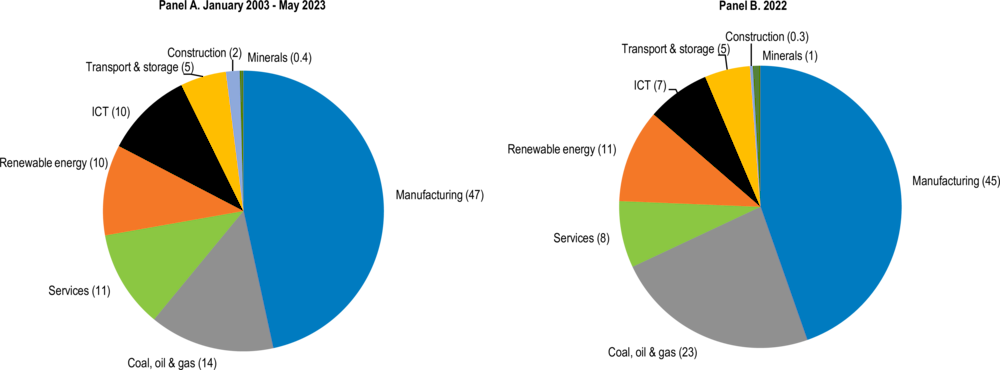
Note: Data cover January 2003 to May 2023. Services includes: business services, financial services, health care, hotels and tourism, and leisure and entertainment. Construction includes: real estate. ICT includes: communications, and software and IT services. The LAC country group includes 27 countries: Antigua and Barbuda, Argentina, Bahamas, Barbados, Belize, Bolivia, Brazil, Chile, Colombia, Costa Rica, Cuba, Dominican Republic, Ecuador, El Salvador, Guatemala, Guyana, Honduras, Jamaica, Mexico, Nicaragua, Panama, Paraguay, Peru, Saint Lucia, Trinidad and Tobago, Uruguay, and Venezuela.
Source: Authors’ elaboration based on (fDi Markets, 2023[51]; ECLAC, 2023[49]).
Foreign direct investment for better jobs
FDI from the EU and the USA has contributed significantly to formal job creation in the LAC region over the last two decades. In fact, since 2006, investments originating in these two territories have consolidated as the main foreign generators of formal jobs in the region. Investments announced in 2022 coming from the United States are expected to generate almost 108 000 jobs and EU investments 86 000 jobs, followed by Canada (10 000) and China (9 000). FDI originating from LAC countries announced in 2022 is expected to generate around 30 000 jobs (Figure 2.13).
Figure 2.13. Total formal jobs created by FDI in LAC, by country of origin, 2003-22
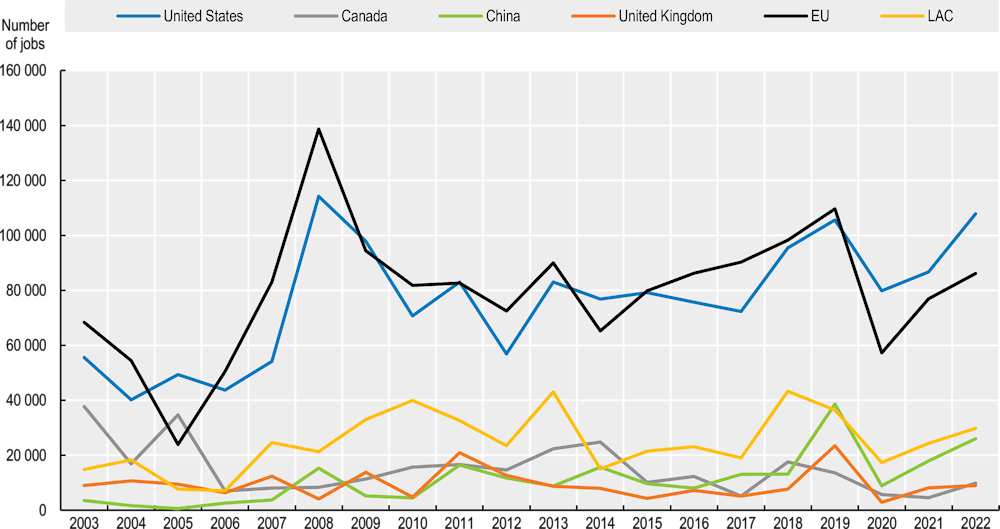
Note: fDi Markets reports how many jobs are expected to be generated from each FDI announcement. The LAC country group includes 27 countries: Antigua and Barbuda, Argentina, Bahamas, Barbados, Belize, Bolivia, Brazil, Chile, Colombia, Costa Rica, Cuba, Dominican Republic, Ecuador, El Salvador, Guatemala, Guyana, Honduras, Jamaica, Mexico, Nicaragua, Panama, Paraguay, Peru, Saint Lucia, Trinidad and Tobago, Uruguay, and Venezuela.
Source: Authors’ elaboration based on (fDi Markets, 2023[51]).
At the sectoral level in LAC, the majority of FDI goes to manufacturing and the energy and extraction sectors. Manufacturing has been the top destination sector in the last 20 years, with more than 40% of participation in FDI (Figure 2.14, Panel A). This sector is also first in job generation from FDI in LAC (Figure 2.14, Panel B). For all main partners, the manufacturing sector’s participation in jobs generated is higher than its participation in capital invested, showing a high contribution to the economy. The services sector also has a high impact on job generation, especially in the case of investments originating in the European Union and the United States. In contrast, the energy and extraction sector has a small impact on employment, as it has higher participation in capital invested than in jobs generated (for all countries considered). For instance, in the case of the European Union, 31% of the capital is invested in energy and extraction but only 6% of jobs generated are in that sector. In the same vein, 24% of the region’s FDI from the United States targeted the energy and extraction sector, but this only created 3% of jobs (Figure 2.14, Panels A and B). Additionally, it’s worth noting that FDI in renewable energy results in higher job creation than FDI in fossil fuels. To illustrate, a USD 1 billion investment in fossil fuels generates around 500 new jobs in LAC, while the same investment in renewables creates 800 jobs. Data can be a powerful tool to broaden the impact of FDI on employment. Knowing precisely what type of operations are run by foreign companies in the LAC region – and the type of skills and capacities they are demanding – could help to guide better labour policies and create new formal jobs.
Figure 2.14. Capital expenditure and formal jobs created by FDI in LAC, January 2003-May 2023
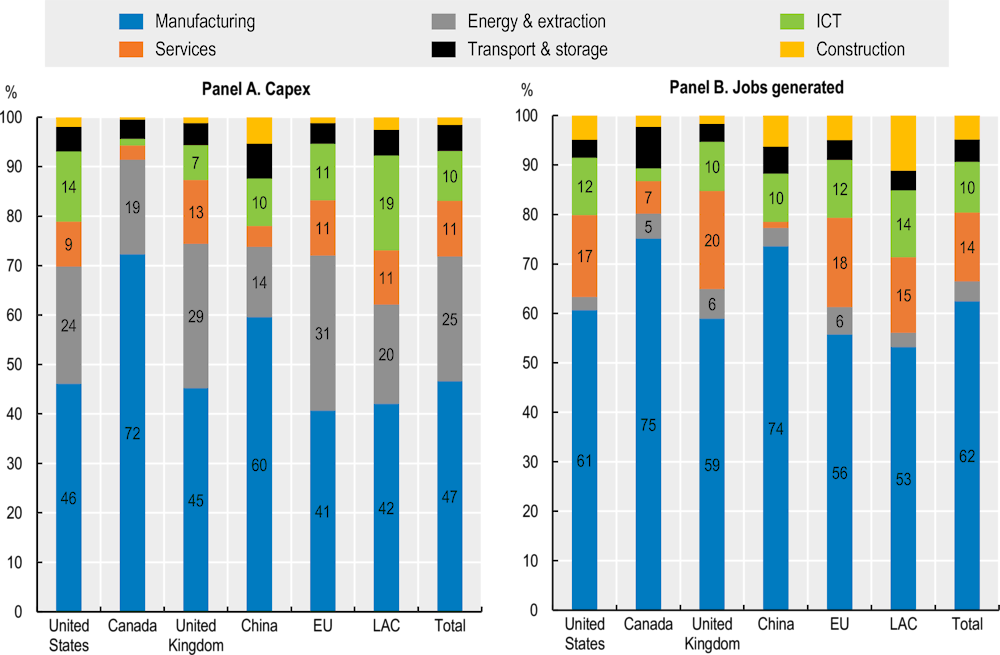
Note: ICT = information and telecommunication technologies. Capex = capital expenditures. Data covers January 2003 to May 2023. Energy and extraction includes: coal, oil and gas; minerals and renewable energy. Services includes: business services, financial services, health care, hotels and tourism, and leisure and entertainment. Construction includes: real estate. ICT includes: communications, and software and IT services. The LAC country group includes 27 countries: Antigua and Barbuda, Argentina, Bahamas, Barbados, Belize, Bolivia, Brazil, Chile, Colombia, Costa Rica, Cuba, Dominican Republic, Ecuador, El Salvador, Guatemala, Guyana, Honduras, Jamaica, Mexico, Nicaragua, Panama, Paraguay, Peru, Saint Lucia, Trinidad and Tobago, Uruguay, and Venezuela.
Source: Authors’ elaboration based on (fDi Markets, 2023[51]).
FDI could be a source not only of higher employment but also of better quality jobs and the development of human capital (OECD, 2023[53]). The OECD’s FDI Qualities Indicators seek to shed light on the extent to which FDI contributes to sustainable development, focusing on productivity and innovation, job quality and skills, gender equality, and the low carbon-transition (OECD, 2019[54]; OECD, 2022[55]).
In the case of the LAC region, the FDI Qualities Indicators show that foreign firms tend to offer higher average wages, suggesting that the enhanced productivity level they enjoy is at least in part transferred to employees (Figure 2.15, Panel A). At the same time, in the majority of Latin American countries considered, foreign firms tend to employ a higher proportion of unskilled workers than domestic firms do and are significantly more likely to offer training opportunities (Figure 2.15, Panels B and C). This suggests that foreign investors are an important source of employment for low-skilled workers in Latin America and can make a significant contribution to upgrading their skills and increasing their opportunities for future employment. To enhance FDI’s contribution to quality job creation, investment promotion efforts in LAC should be aligned with well-defined production development policies that promote economic diversification and with other investment-related policies (OECD et al., 2021[56]; OECD, 2022[1]; OECD, 2022[55]; ECLAC, 2023[49]).
Figure 2.15. Job-related FDI Qualities Indicators for selected LAC countries, 2019
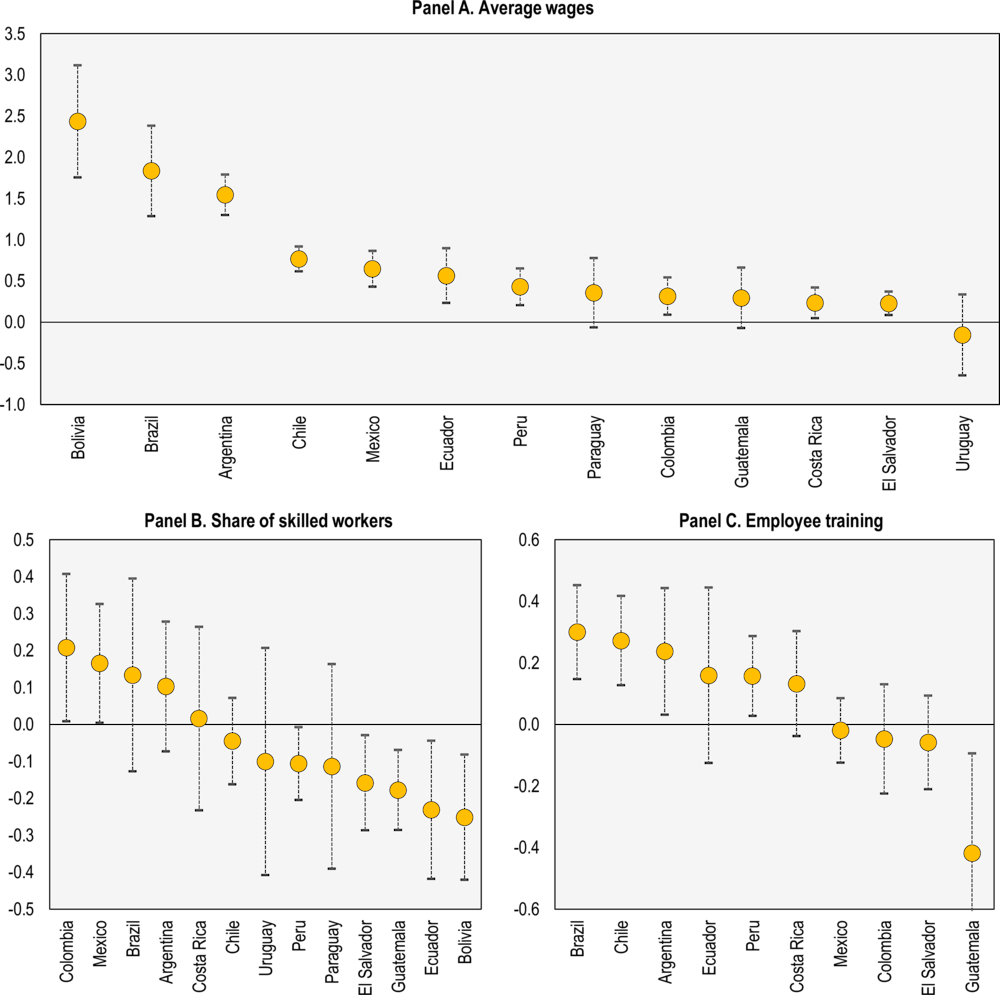
Note: In the figure, the orange dots depict the estimation of the indicator while the dash lines represent the corresponding confidence interval. If the value is >0, foreign firms perform better than domestic firms. Based on 2019 data or the latest.
Source: Based on (OECD et al., 2021[56]; OECD, 2019[54]).
The impact of FDI on productivity, innovation and environmental sustainability
FDI also has the potential to influence innovation and productivity in the host economies. According to the OECD FDI Qualities Indicators, and across most countries for which data are available, foreign investors are more productive and more likely to introduce product innovation or invest in R&D than domestic firms (Figure 2.16, Panels A-C). This productivity and innovation gap suggests that potential exists for knowledge and technology spillovers from foreign to domestic firms. To maximise the impact of FDI on productivity and innovation, policy objectives must be aligned across government levels and policy areas; this includes co-operation from public institutions at national and subnational levels, and co-ordinating with SMEs to create stronger business linkages and innovation ecosystems (OECD, 2022[1]).
Figure 2.16. Productivity and innovation: FDI qualities indicators for selected LAC countries, 2019

Note: In the figure, the orange dots depict the estimation of the indicator while the dash lines represent the corresponding confidence interval. If the value is >0, foreign firms perform better than domestic firms. Based on 2019 data or the latest. For methodological details, www.oecd.org/fr/investissement/fdi-qualities-indicators.htm.
Source: Based on (OECD et al., 2021[56]; OECD, 2019[54]).
Although FDI shows great potential to contribute to sustainable development, at the aggregate level in most LAC economies, it currently appears more carbon intensive than domestic investment. However, some industries with high emissions per unit of output benefit from the presence of foreign firms with lower carbon intensity.
In terms of the overall economy, foreign firms in LAC economies generate between 4% and 75% more emissions per unit of output than domestic firms (Figure 2.17). Example of places where the differences are greatest – as measured by metric tonnes (Mt) of carbon dioxide (CO2) emissions per unit of output – include the coke and refined petroleum products industry in Costa Rica, where foreign firms emit about 24 more MtCO2, and electricity and other utilities in Colombia (6 more MtCO2). Foreign companies in the Mexican transport and storage sector and in the Brazilian wood industry also have a higher carbon intensity than domestic competitors, although at a lower level, suggesting that scope remains for improving the carbon performance of FDI in these sectors (OECD, 2023[57]).
Figure 2.17. Carbon intensity of output by ownership, MtCO2 per million USD
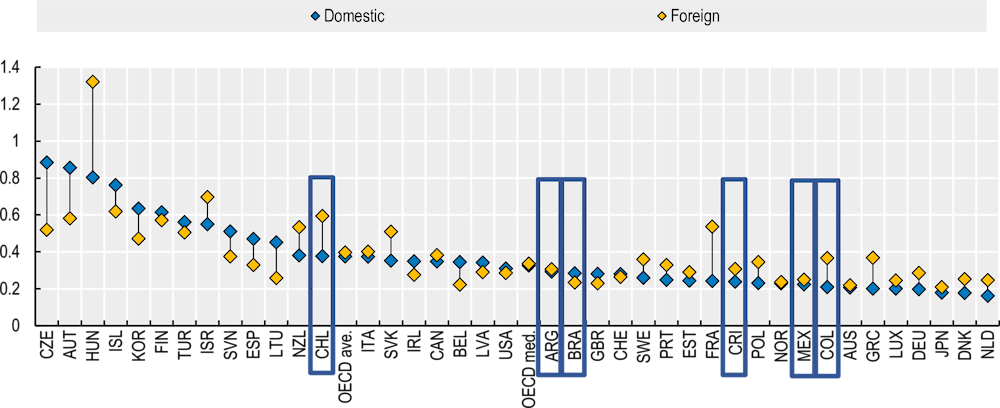
Note: The figure shows carbon intensities – i.e. carbon emissions per unit of output – of foreign and domestic firms at the aggregate country level. To obtain country-level values, values for individual sectors were aggregated using shares of each sector’s output in the country’s total output as weights.
Source: (OECD, 2023[57]).
Given its natural endowments, such as wind and sun, the LAC region has capacity to attract large investments in renewable energy. New FDI projects in renewable energy (greenfield projects) have been rising over the last two decades, while FDI projects in fossil fuels have slightly decreased (Figure 2.18, Panel A). Since 2011, FDI in renewable energy has surpassed FDI in fossil fuels almost steadily, highlighting FDI’s growing contribution to the energy transition. However, the increase in cross-border investment in renewables has been uneven across LAC economies, and FDI in renewable energy has not yet recovered from the COVID-19 crisis (OECD, 2023[57]). Box 2.5 presents a brief compilation of messages on how LAC countries can deepen and expand relations to scale up cross-border investment in renewables.
Box 2.5. LAC countries can further expand investment relations with OECD countries for renewable energy FDI
Given that LAC governments are already facing a tight fiscal space, FDI has a crucial role in securing essential resources for the green transition (Chapter 1). To decarbonise the energy mix by 2050, the LAC region will need to invest USD 1 billion in total (UNEP, 2016[58]).
Even if FDI projects in renewable energy increased more than sixfold over the past two decades in LAC, investment remains highly concentrated. Brazil, Chile and Mexico together received three quarters of all opened and announced renewable energy FDI in the region since 2003 (Chapter 3).
To promote more and better cross-border investment in renewables, other LAC countries could leverage the funds coming from the main investors from OECD countries. Argentina, Colombia, Costa Rica, the Dominican Republic, Ecuador, El Salvador, Guatemala, Honduras, Paraguay, Peru, Uruguay and other countries could further target the main investors in renewable energy. Currently, with 27% of total investment, Spain represents the primary source of greenfield FDI (i.e. new projects in which a company constructs its own new operational facilities), closely followed by the United States and Canada. When considering the combined contributions of these three nations, they collectively account for 44% of the total greenfield FDI in renewable energy.
Nevertheless, LAC countries have a valuable opportunity to further expand investment relations with major countries investing in renewable energy abroad. Countries such as Australia, France, Germany, Italy and Ireland host a significant portion of global FDI projects in renewables, yet their representation within the region remains relatively small in terms of percentage. For example, Germany accounts for 10% of global FDI projects in renewable energy (2003-22) but only represents 5% in LAC.
Source: Authors’ elaboration based on (UNEP, 2016[58]; OECD, 2023[57]).
The variation in FDI in energy remains wide across LAC countries. In Argentina, Colombia, Ecuador, El Salvador, Guatemala, Mexico and Peru fossil fuels account for about 10% to 50% of total greenfield FDI accumulated since 2003 and for more than 50% of FDI stocks in the energy sector (Figure 2.18, Panel B). Conversely, in Paraguay, Brazil, Uruguay, Dominican Republic, Honduras and Chile, renewable energy FDI dominates the energy sector and has attracted a sizable share of total greenfield FDI, ranging from 10% in Paraguay to 30% in Chile. Especially in Honduras, almost all open and announced FDI projects in the energy sector are directed to renewable energy (93%). Notably, Honduras has the lowest level of rural electrification among the LAC economies under consideration; it can thus benefit from renewable energy FDI not only to reduce emissions but also to close the gap in access to energy and to promote sustainable development (OECD, 2023[57]). Moreover, quality FDI could contribute to the development in LAC of strategic sectors such as the energy, sustainable mobility, pharmaceuticals and sustainable agribusiness (Chapter 3). These sectors can foster a more dynamic and resilient economy while helping to advance the green transition.
Figure 2.18. Share of greenfield FDI by energy type for LAC and selected LAC countries, 2003-22
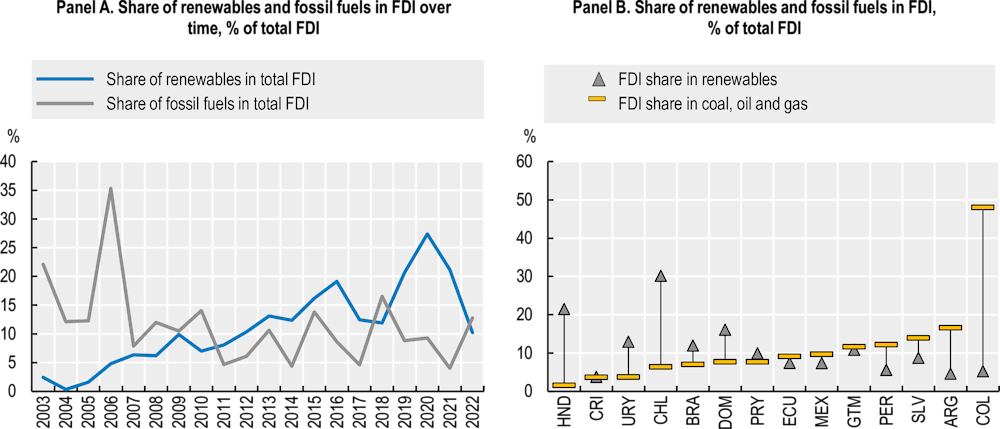
Note: This figure shows the share of all opened and announced greenfield FDI projects in renewables and fossil fuels as a share of total greenfield FDI in LAC over time (Panel A) and by country (Panel B). In Panel A, LAC comprises Argentina, Brazil, Chile, Colombia, Costa Rica, Dominican Republic, Ecuador, El Salvador, Guatemala, Honduras, Mexico, Paraguay, Peru, and Uruguay. Panel B corresponds to the stock for 2003-22.
Source: (OECD, 2023[57]).
Key policy messages
The LAC region is experiencing lower levels of investment than any other developing region. Total investment as a percentage of GDP was falling already before the COVID-19 crisis. After a small rebound, it averaged 20.4% of GDP in 2022.
Although heterogeneity is evident across LAC countries, to ensure an inclusive and sustainable structural transformation, total investment will have to increase in all strategic sectors. To achieve this, governments from LAC will have to mobilise more and better private and public investment. Quality public infrastructure in key sectors, including sustainable transport, telecommunications, and water, can boost the well-being of citizens and help LAC countries move towards the SDGs.
Governments from the region can raise investment levels through good governance and a series of financing tools and strategies. Properly designed PPPs, accompanied by elements of de-risking, can motivate the private sector to invest in strategic long-term public projects with high social impact. FDI can also play a strategic role in filling the current investment gap. LAC already attracts larger sums of FDI than other developing regions and could build on this to amplify future investments. By strategically targeting FDI with a larger potential to share know-how, create quality jobs and implement sustainable methods of production, governments could support the objectives of sustainable and inclusive production transformation in LAC. Box 2.6 presents the main policy messages for achieving the objectives described throughout the chapter.
Box 2.6. Key policy messages
Towards more and better investments to drive sustainable and inclusive development
-
Advance in creating a better investment climate through a mix of co-ordinated policy efforts, as described by the OECD Policy Framework for Investment. In terms of public governance, four key pillars stand out: quality regulation, transparency, openness and integrity.
-
Develop clear and accessible datasets on infrastructure investment. This information should provide tools and evidence for policy makers to properly design public policy for better investments and to better assess potential investment, including by carrying out sound cost-benefit analyses. Such datasets should also allow the rest of the stakeholders to better understand who is developing each sector.
-
Strengthen government collaboration with the private sector and academia to further promote reliable and accessible infrastructure databases and to ensure efficient use of the resources already deployed.
-
Develop investment regulatory frameworks on infrastructure and enhance co-ordination among jurisdictions to:
-
promote coherent, predictable and efficient regulatory frameworks
-
promote competition among investors
-
provide clarity and transparency (enabling investors to plan their investment for long-term periods)
-
distribute clear responsibilities among stakeholders for each investment, and
-
achieve harmonised regulations in line with similar national, regional and international frameworks (vertical harmonisation) and across investment, trade and fiscal systems to boost production and avoid tax evasion (horizontal harmonisation).
-
-
Ensure the governance of infrastructure brings well-being to citizens by including relevant stakeholders in its design and implementation, basing infrastructure decisions on reliable evidence, and using digital technologies to facilitate easy access to information and transparency.
-
Adopt the OECD Recommendations on the Governance of Infrastructure to:
-
maximise the impact of investment in sustainable infrastructure to ensure its resilience over time, including to the effects of increasing extreme weather events.
-
actively include methods of citizen participation to ensure that new infrastructure is truly inclusive and respects local communities and the environment.
-
-
Ensure that investment in transport promotes appropriate modes of transportation, the use of sustainable public transport and shared mobility.
-
Work closely with telecommunications enterprises to promote further investment. Key objectives should include: strengthening the weakest territories and agents and helping boost the technological absorption of the economy; facilitating the transformation of business models; and consolidating the integration into more dynamic and innovative production systems.
-
Ensure that investment in water infrastructure provides equitable and inclusive access to drinkable water. Expand the water network to ensure the amount and quality of drinkable water are adequate. Adapt future investment in water infrastructure to increase resilience to face future risks such as droughts or sea-level rise.
Towards sound PPP frameworks
-
Enhance the regulatory framework for PPPs (e.g. comprehensive rules for project selection, risk allocation and contract management) and build technical capacity in their design, implementation and oversight to avoid costly renegotiations and ensure their success.
-
Create a predictable and transparent investment environment that bolsters investor confidence and maximises the socioeconomic and environmental impacts of PPPs.
-
Enable efficient and effective citizen participation in the decision-making process to foster a sense of ownership and greater accountability, which in turn could help avoid social conflicts throughout the projects.
-
Promote sustainable and diversified PPPs to achieve balanced development across sectors and ensure long-term sustainability. Governments should advocate to incorporate comprehensive environmental impact assessments into PPP planning.
Towards the attraction of quality FDI to boost strategic sectors
-
Align efforts to promote investment in well-defined production sectors, including renewable energy, to enhance the contribution of FDI to inclusive and sustainable development in LAC.
-
Channel FDI to create quality jobs and support skills development. This requires collecting information about the operations of foreign firms as well as skills needs to create skills anticipation systems, training programmes and wide pro-competition policies that increase potential labour-market gains.
-
Create successful investment promotion policies by ensuring co-ordination among public institutions at national and subnational levels within the framework of production development policies.
-
Involve SMEs in the process, including them in international agreements, providing technical and financial assistance, and promoting intersectoral connections to create business linkages.
References
Atlantic Council (2023), Unlocking Economic Development in Latin America and the Caribbean: Five Opportunities for Private-Sector Leadership and Partnership, Atlantic Council, Washington, DC, https://www.atlanticcouncil.org/wp-content/uploads/2023/06/AALAC_IDB_Report_060823_complete.pdf.
Bitrán, E., S. Nieto Parra and J. Robledo (2013), “Opening the black box of contract renegotiations: An analysis of road concessions in Chile, Colombia and Peru”, OECD Development Centre Working Papers, No. 317, OECD Publishing, Paris, https://doi.org/10.1787/5k46n3wwxxq3-en.
CAF (2021), Pathways to Integration: Trade Facilitation, Infrastructure and Global Value Chains, Development Bank of Latin America (CAF), Caracas, https://scioteca.caf.com/handle/123456789/1823.
CAF (2018), Public-Private Partnership in Latin America. Facing the Challenge of Connecting and Improving Cities, Development Bank of Latin America (CAF), Bogota, https://scioteca.caf.com/bitstream/handle/123456789/1549/Public-Private_Partnership_in_Latin_America._Facing_the_challenge_of_connecting_and_improving_cities..pdf.
Ding, D. et al. (2021), “Chinese investment in Latin America: Sectoral complementarity and the impact of China’s rebalancing”, IMF Working Papers, No. 160, Washington, DC, https://www.imf.org/en/Publications/WP/Issues/2021/06/07/Chinese-Investment-in-Latin-America-Sectoral-Complementarity-and-the-Impact-of-Chinas-50217.
ECLAC (2023), “CEPALSTAT”, Foreign direct investment (FDI) inflows, https://agenda2030lac.org/estadisticas/regional-data-bank-statistical-follow-up-sdg-1.html?indicator_id=4231&lang=en (accessed on 5 September 2023).
ECLAC (2023), Foreign Direct Investment in Latin America and the Caribbean 2023, United Nations Economic Commission for Latin America and the Caribbean, Santiago, https://www.cepal.org/en/publications/48979-foreign-direct-investment-latin-america-and-caribbean-2023.
ECLAC (2022), Economic Survey of Latin America and the Caribbean 2022: Trends and Challenges of Investing for a Sustainable and Inclusive Recovery, United Nations Economic Commission for Latin America and the Caribbean, Santiago, https://repositorio.cepal.org/bitstream/handle/11362/48078/7/S2201057_en.pdf.
ECLAC (2022), Foreign Direct Investment in Latin America and the Caribbean 2022, United Nations Economic Commission for Latin America and the Caribbean, Santiago, https://repositorio.cepal.org/bitstream/handle/11362/48521/3/S2200561_en.pdf.
ECLAC (2022), Redes 5G en América Latina: Desarrollo y potencialidades, United Nations Economic Commission for Latin America and the Caribbean, Santiago, https://repositorio.cepal.org/handle/11362/48485.
ECLAC (2021), “Digital technologies for a new future”, United Nations Economic Commission for Latin America and the Caribbean, Santiago, http://repositorio.cepal.org/handle/11362/46817.
ECLAC (2020), “Public-private partnerships under the ‘people-first’ approach”, United Nations Economic Commission for Latin America and the Caribbean, Santiago, https://repositorio.cepal.org/bitstream/handle/11362/46538/1/S2000676_en.pdf.
ECLAC (2019), Perspectivas del Comercio Internacional de América Latina y el Caribe 2019: El adverso contexto mundial profundiza el rezago de la región, United Nations Economic Commission for Latin America and the Caribbean, Santiago, https://www.cepal.org/es/publicaciones/44918-perspectivas-comercio-internacional-america-latina-caribe-2019-adverso-contexto.
ECLAC (2018), Economic Survey of Latin America and the Caribbean 2018, United Nations Economic Commission for Latin America and the Caribbean, Santiago, https://www.cepal.org/en/publications/43965-economic-survey-latin-america-and-caribbean-2018-evolution-investment-latin.
ECLAC (2012), “Public-private partnerships in renewable energy in Latin America and the Caribbean”, United Nations Economic Commission for Latin America and the Caribbean, Santiago, https://www.cepal.org/es/publicaciones/4016-public-private-partnerships-renewable-energy-latin-america-and-caribbean.
ECLAC (2004), “La inversión para la provisión de servicios públicos y su financiamiento en América Latina y el Caribe: evolución reciente, situación actual y políticas”, United Nations Economic Commission for Latin America and the Caribbean, Santiago, https://repositorio.cepal.org/handle/11362/5396.
Economist Impact (2022), “Evaluating the environment for public-private partnerships in Latin America and the Caribbean: The 2021/22 Infrascope”, Economist Impact, New York, https://infrascope.wpengine.com/wp-content/uploads/2019/04/EIU_INFRASCOPE_2021_12.pdf.
Eichengreen, B. (2010), Lessons from the Marshall Plan, https://documents1.worldbank.org/curated/en/907961468155715855/pdf/620420WP0Lesso0BOX0361475B00PUBLIC0.pdf.
EIU (2019), “Evaluating the environment for public-private partnerships in Latin America and the Caribbean: The 2019 Infrascope”, The Economist Intelligence Unit, New York, https://infrascope.eiu.com/wp-content/uploads/2019/04/EIU_2019-IDB-Infrascope-Report_FINAL-1.pdf.
Engel, E., R. Fischer and A. Galetovic (2021), “When and how to use public-private partnerships in infrastructure: Lessons from the international experience”, National Bureau of Economic Research, Cambridge, MA, https://www.nber.org/papers/w26766.
European Commission et al. (2008), System of National Accounts 2008, European Communities, IMF, OECD, UN, WB, New York, https://unstats.un.org/unsd/nationalaccount/docs/sna2008.pdf.
fDi Markets (2023), fDi Markets, https://www.fdimarkets.com/.
IDB (2022), Informe anual del Índice de Desarrollo de la Banda Ancha: Brecha digital en América Latina y el Caribe, Inter-American Development Bank, Washington, DC, https://doi.org/10.18235/0004379.
IDB (2022), Sustainable Financing of Economic and Social Infrastructure in Latin America and the Caribbean: Trends, Key Agents and Instruments, Inter-American Development Bank, Washington, DC, https://publications.iadb.org/publications/english/viewer/Sustainable-Financing-of-Economic-and-Social-Infrastructure-in-Latin-America-and-the-Caribbean-Trends-Key-Agents-and-Instruments.pdf.
IDB (2022), Water access in Latin America and the Caribbean: Definitions and data, Inter-American Development Bank, Washington, DC, https://doi.org/10.18235/0004493.
IDB (2021), The Infrastructure Gap in Latin America and the Caribbean: Investment Needed Through 2030 to Meet the Sustainable Development Goals, Inter-American Development Bank, Washington, DC, https://publications.iadb.org/en/infrastructure-gap-latin-america-and-caribbean-investment-needed-through-2030-meet-sustainable.
IDB (2023), Brecha de conectividad y necesidades de inversión en América Latina y el Caribe: una perspectiva económico-financiera, Inter-American Development Bank, Washington, DC.
IMF (2023), World Economic Outlook Database, International Monetary Fund, Washington, DC, https://www.imf.org/en/Publications/WEO/weo-database/2023/April/weo-report (accessed on 5 September 2023).
IMF (2022), Investment and Capital Stock Dataset, International Monetary Fund, Washington, DC, https://data.imf.org/?sk=1CE8A55F-CFA7-4BC0-BCE2-256EE65AC0E4&sId=1390030341854 (accessed on 5 September 2023).
INEGI (2023), Recomendaciones para la Generación de Información sobre Infraestructura en México, National Institute of Statistics and Geography (INEGI), Aguascalientes, https://www.inegi.org.mx/infraestructura/modelos/.
Infralatam (2022), Data on Public Investment in Economic Infrastructure in Latin America and the Caribbean (database), http://infralatam.info/en/home/ (accessed on 5 September 2023).
ITF and IADB (2022), Decarbonising Transport in Latin American Cities. A Review of Policies and Key Challenges, Inter-American Development Bank, Washington, DC, https://publications.iadb.org/publications/english/viewer/Decarbonising-Transport-in-Latin-American-Cities-A-Review-of-Policies-and-Key-Challenges.pdf.
OECD (2023), “Investment (GFCF)” (indicator), https://doi.org/10.1787/b6793677-en (accessed on 24 August 2023).
OECD (2023), FDI Qualities Review of Chile: Boosting Sustainable Development and Diversification, OECD Publishing, Paris, https://doi.org/10.1787/98bf1829-en.
OECD (2023), OECD Foreign direct investment (FDI), OECD Publishing, Paris, https://doi.org/10.1787/9a523b18-en.
OECD (2022), “FDI Qualities Indicators: Measuring the sustainable development impacts of investment”, OECD, https://www.oecd.org/investment/fdi-qualities-indicators.htm.
OECD (2022), FDI Qualities Policy Toolkit, OECD Publishing, Paris, https://www.oecd-ilibrary.org/finance-and-investment/fdi-qualities-policy-toolkit_7ba74100-en.
OECD (2021), OECD Implementation Handbook for Quality Infrastructure Investment, OECD Publishing, Paris, https://www.oecd.org/finance/oecd-implementation-handbook-for-quality-infrastructure-investment.htm.
OECD (2020), “Recommendation of the Council on the Governance of Infrastructure”, OECD Legal Instruments, OECD Publishing, Paris, https://legalinstruments.oecd.org/en/instruments/OECD-LEGAL-0460.
OECD (2020), OECD Compendium of Policy Good Practices for Quality Infrastructure Investment, OECD Publishing, Paris, https://www.oecd.org/finance/OECD-compendium-of-policy-good-practices-for-quality-infrastructure-investment.pdf.
OECD (2019), Effective Public Investment Across Levels of Government: Implementing the OECD Principles, OECD Publishing, Paris, https://www.oecd.org/effective-public-investment-toolkit/OECD_Public_Investment_Implementation_Brochure_2019.pdf.
OECD (2019), Enhancing Access to and Sharing of Data: Reconciling Risks and Benefits for Data Re-use across Societies, OECD Publishing, Paris, https://doi.org/10.1787/276aaca8-en.
OECD (2019), FDI Qualities Indicators: Measuring the sustainable development impacts of investment, OECD Publishing, Paris, https://www.oecd.org/investment/FDI-Qualities-Indicators-Measuring-Sustainable-Development-Impacts.pdf.
OECD (2015), Policy Framework for Investment, 2015 Edition, OECD Publishing, Paris, https://doi.org/10.1787/9789264208667-en.
OECD (2015), Recommendation of the Council on Public Procurement, OECD Publishing, Paris, https://legalinstruments.oecd.org/en/instruments/OECD-LEGAL-0411.
OECD (2009), Private Sector Participation in Water Infrastructure: OECD Checklist for Public Action, OECD Publishing, Paris, https://www.oecd.org/env/resources/42350657.pdf.
OECD (2008), Conducting Sustainability Assessments, OECD Sustainable Development Studies, OECD Publishing, Paris, https://doi.org/10.1787/9789264047266-en.
OECD (2023), Harnessing the Potential of Foreign Direct Investment to Advance the Low-Carbon Transition in Latin America and the Caribbean, OECD, Paris, https://storageprdv2inwink.blob.core.windows.net/fd64104f-b9d5-4759-8902-1297bb45b3fd/477af9b7-c0cd-4b91-8dee-20b657717e27.
OECD and IDB (2016), Broadband Policies for Latin America and the Caribbean: A Digital Economy, OECD Publishing, Paris, https://doi.org/10.1787/9789264251823-en.
OECD et al. (2022), Latin American Economic Outlook 2022: Towards a Green and Just Transition, OECD Publishing, Paris, https://doi.org/10.1787/3d5554fc-en.
OECD et al. (2021), Latin American Economic Outlook 2021: Working Together for a Better Recovery, OECD Publishing, Paris, https://doi.org/10.1787/5fedabe5-en.
OECD et al. (2020), Latin American Economic Outlook 2020: Digital Transformation for Building Back Better, OECD Publishing, Paris, https://doi.org/10.1787/e6e864fb-en.
OECD (2012), Water Governance for Latin America and the Caribbean: A Multi-level approach, OECD Studies on Water, OECD Publishing, Paris, https://doi.org/10.1787/9789264174542-en.
UNEP (2016), Carbono cero América Latina: Una Vía para la Descarbonización Neta de la Economía Regional Para Mediados de Este Siglo - Documento de Visión, https://wedocs.unep.org/20.500.11822/26305.
World Bank (2023), “World Development Indicators” (database), World Bank Group, Washington, DC, https://data.worldbank.org/indicator (accessed on 19 September 2023).
World Bank (2023), Private participation in infrastructure (database), World Bank Group, Washington, DC, https://ppi.worldbank.org/en/customquery (accessed on 5 September 2023).
World Bank (2022), Private Participation in Infrastructure (PPI): 2022 Annual Report, World Bank Group, Washington, DC, https://ppi.worldbank.org/content/dam/PPI/documents/PPI-2022-Annual-Report.pdf.
World Bank (2021), Private Participation in Infrastructure: 2021 Annual Report, World Bank Group, Washington, DC, https://ppi.worldbank.org/content/dam/PPI/documents/PPI-2021-Annual-Report.pdf.
World Bank (2019), A Guide to Community Engagement for Public-Private Partnerships: Draft for Discussion, World Bank Group, Washington, DC, https://ppp.worldbank.org/public-private-partnership/library/guide-community-engagement-public-private-partnerships-june-2019.
World Bank (2016), Public and private paths to sustainable water supply and sanitation in Colombia, World Bank Group, Washington, DC, https://ieg.worldbankgroup.org/sites/default/files/Data/reports/ppar_colombia_01132017.pdf.
Annex 2.A. Methodological annex
Figure 2.2. Total investment as a percentage of GDP in selected LAC countries, 2022
Regarding the investment and capital stock dataset (IMF, 2022[12]): Public investment is measured using gross fixed capital formation of the general government (i.e. central plus subnational governments). This approach does not include: i) investment grants, which are transfers from central and/or subnational governments to public and private entities outside the general government to support investment in fixed assets; ii) loan guarantees; iii) tax concessions, such as those for mortgage interest, R&D, and municipal bonds; iv) the operations of public financial institutions, such as development banks, that provide long-term funding at subsidised rates; and v) government-backed saving schemes.
Statistics for the OECD countries are taken from the December 2020 version of the OECD Economic Outlook. Specifically, the series retrieved (in national currency and constant prices) is comprised of general government GFCF and total GFCF.
Figure 2.5. Public investment in infrastructure in LAC, as a percentage of GDP, Panel B
Argentina: The data include investment by the central government, subnational governments and public companies. However, in subnational investments, only investments made with funds transferred from the national government are recorded. Central government data include real direct investment from the national public administration, advances to long-term suppliers (priority investment projects), and capital transfers (excluding capital transfers to companies and provincial and municipal institutions). Data from subnational governments include capital transfers to provincial and municipal institutions. Investment expenditures financed with resources collected by the provinces and municipalities are excluded.
Chile: Investments made by the infrastructure concessions programme are not included.
El Salvador: The water and sanitation data include non-financial public companies and a part of local governments. There are no data on investment in water and sanitation executed by the central government and by non-business decentralised institutions.
Guatemala: Subnational investments are not included; since local governments report total investments without discrimination, it is not possible to identify investments corresponding to infrastructure sectors.
Honduras: As of 2018, “total transportation” includes the “transportation and public works” category. “Total energy” for 2020 and 2021 includes renewable energies, while the data for 2019 may include them. Regarding subnational investments, only investments made by the city government of Tegucigalpa for 2011, 2012 and 2013 are included. Data are unavailable for 2008, 2009 and 2010, and for other subnational governments.
Panama: The investment made by the Panama Canal Authority is included.
Dominican Republic: Data since 2009. The “water and sanitation” statistics from 2009 to 2015 cover only sanitation (residual water management, drainage and sewerage). In transportation data from 2016, the total is greater than the sum of its parts because it contains an additional category called “transportation planning, management, and monitoring”.
Uruguay: Data from subnational or departmental governments include only transportation; within this category, only road transportation is included (i.e. urban road infrastructure is not included).
Depending on the sector and the year, statistics were available from different countries. For instance, the calculations corresponding to Figure 2.5, Panel B, for 2021 include:
|
|
Energy |
Telecommunications |
|---|---|---|
|
2021 |
Belize, Bolivia, Dominican Republic, El Salvador, Guatemala, Guyana, Honduras, Panama, Trinidad and Tobago |
Argentina, Belize, Bolivia, Trinidad and Tobago, Uruguay |
|
|
Transport |
Water |
|
2021 |
Argentina, Belize, Bolivia, Dominican Republic, El Salvador, Guatemala, Guyana, Honduras, Panama, Trinidad and Tobago, Uruguay |
Argentina, Belize, Bolivia, Dominican Republic, El Salvador, Guatemala, Guyana, Honduras, Panama, Trinidad and Tobago, Uruguay |
Notes
← 1. This LAC figure includes 30 countries with available data: Antigua and Barbuda, Argentina, Bahamas, Barbados, Belize, Bolivia, Brazil, Chile, Colombia, Costa Rica, Dominica, Dominican Republic, Ecuador, El Salvador, Grenada, Guatemala, Guyana, Honduras, Jamaica, Mexico, Nicaragua, Panama, Paraguay, Peru, Saint Kitts and Nevis, Saint Lucia, Saint Vincent and the Grenadines, Suriname, Trinidad and Tobago, and Uruguay.
← 2. Mexico is not included. Countries included are Costa Rica, El Salvador, Guatemala, Honduras, Nicaragua and Panama.
← 3. When identifying the origin of investment in the region, different sources of information exist. Sources such as fDi Markets and Thomson Reuters are transaction based and therefore take into account the final destination of investments. Official figures reported by the United Nations Conference on Trade and Development (UNCTAD), in contrast, do not take the final destination into account. This difference can cause large discrepancies, especially in the LAC region since many Caribbean Islands are considered Offshore Financial Centres (OFCs) (Ding et al., 2021[59]). For example, China does not seem particularly relevant when looking at official sources, as investments are channelled via OFCs. In 2019, official data indicated that Asia’s contribution to total FDI in LAC was 4%. However, when incorporating OFCs in the calculation of Asia’s FDI stock in LAC, especially from China, this figure surged to 31%. In the same year, a total of USD 4.3 billion – out of USD 6.4 billion in FDI that entered LAC from China – was registered as OFCs, which were not the final destination of the investment (Ding et al., 2021[59]).
